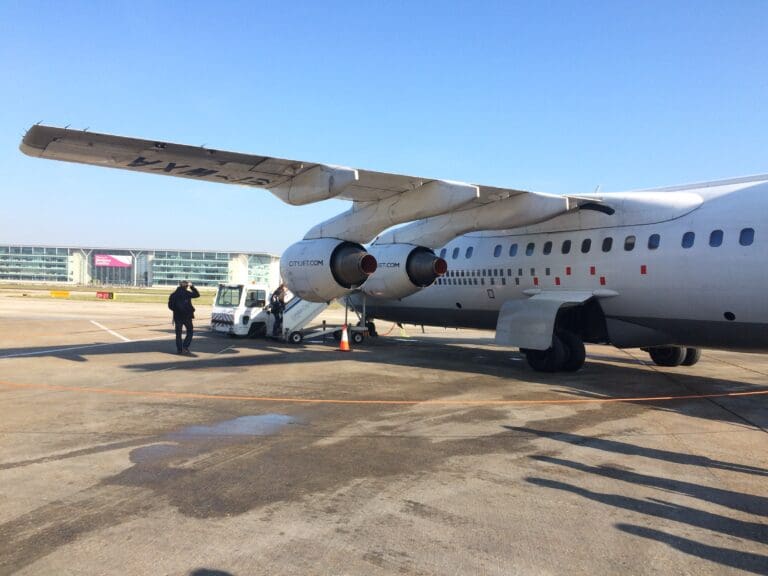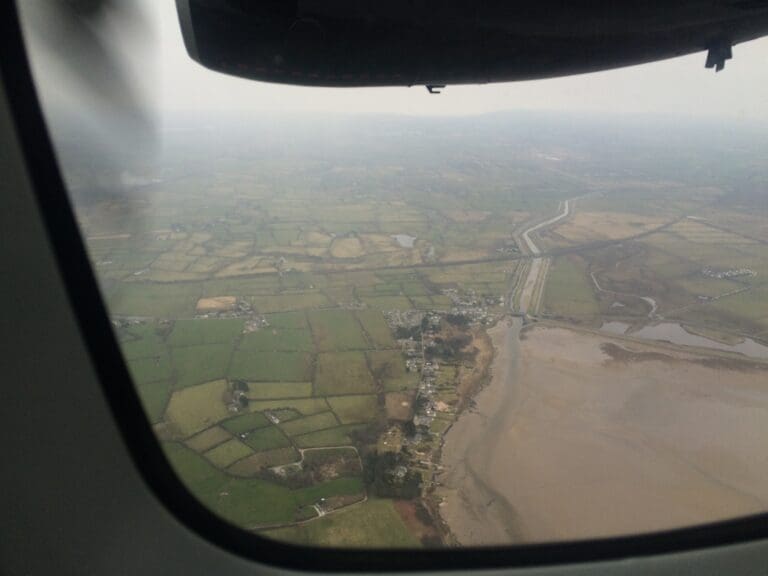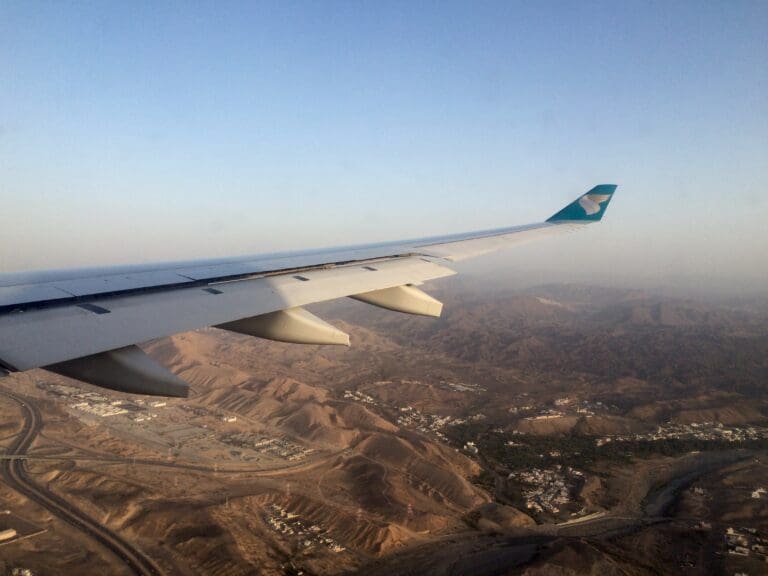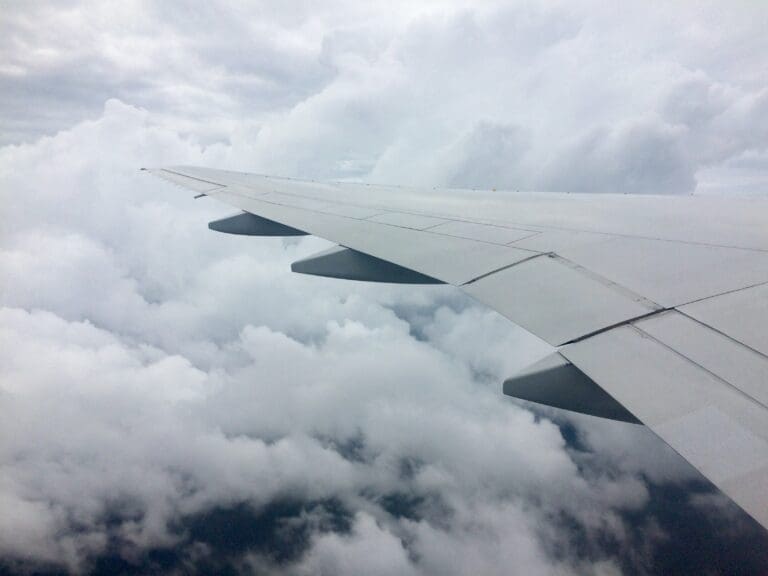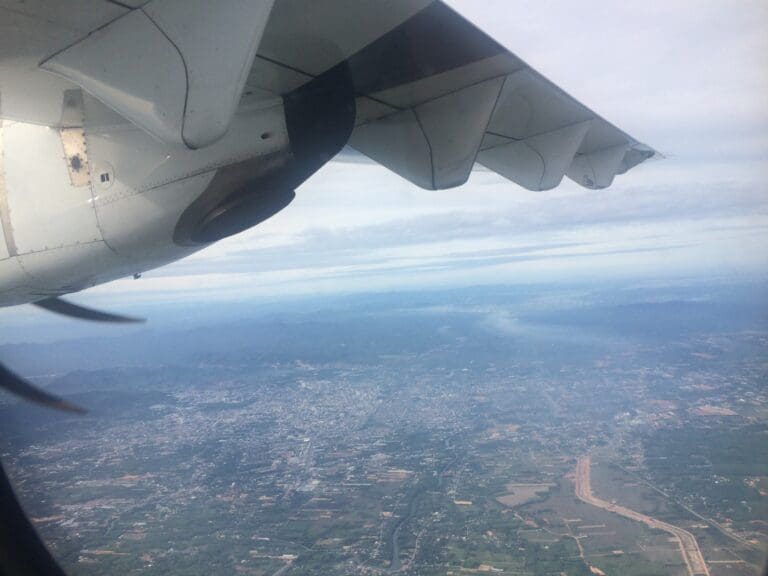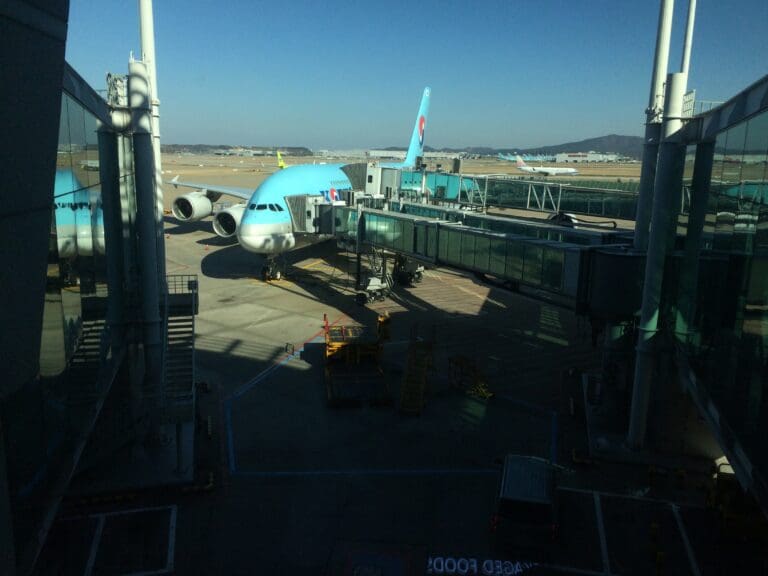Dashing Down to Montréal: An Air Canada Express Dash 8 Q400 Review
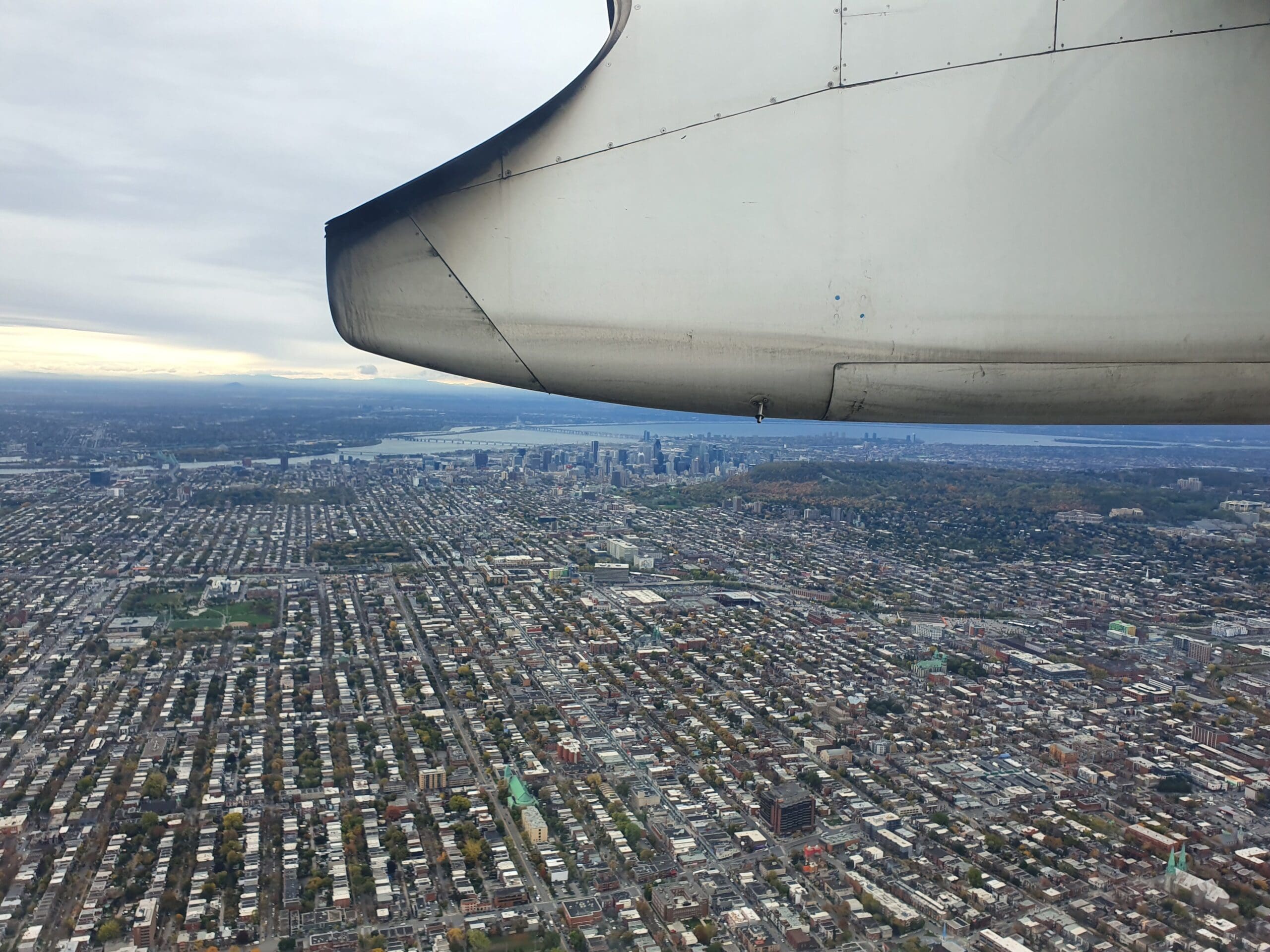
Background
Air Canada Express Dash 8 Q400s can be seen across Canada, from St. John’s in the East to Nanaimo in the West. Being based in the UK, I’ve never seen the Dash 8 Q400 as a rare aircraft type. For years, the aircraft buzzed through Britain’s skies as the mainstay of Flybe’s fleet, and whilst their numbers in Europe have dwindled in recent years, they remain relatively easy to fly. Thus, whilst not seeing the Dash 8 Q400 as being a particularly rare aircraft, given their almost nationwide omnipresence in Canada, it was inevitable that I sampled one whilst in the country.
Needing to get between Québec City and Thunder Bay, and not being particularly bothered about which airline and aircraft I ended up onboard, I voyaged to Skyscanner to find the cheapest possible flights. This revealed a mammoth total of fifteen flight combinations on my day of travel. Of these, most were operated by Air Canada and involved either a single stop in Toronto or in both Montréal and Toronto. Travelling on a budget, I decided to go for the cheapest option which involved first catching an Air Canada Express Dash 8 Q400 down to Montréal, followed by an Airbus A220-300 to Toronto before hopping over onto a Bombardier CRJ-900 for the final portion of my journey to Thunder Bay. In total, this set me back £127 for an Economy Standard ticket. However, pricer options could be had by selecting the Economy Flex, Economy Comfort and Business Class fares, with the latter coming at an acceptable £267.
Booking via Air Canada’s website, I soon clicked on the Economy Standard fare and after rejecting the option to upgrade to Economy Comfort, I entered my details before being given the option to add seats. Skipping past this, I made a quick and easy payment although worryingly, I did not receive any sort of booking confirmation. After several days, I thought it best to contact Air Canada’s customer service helpline and following a pleasantly easy call, my confirmation email was sent over to me and I was all set for my trip to Ontario.
The Journey
As the crow flies, Québec City Jean Lesage International Airport sits around eleven kilometres west of the city centre, equating to a drive of approximately twenty minutes in reasonable traffic conditions. For those lacking a vehicle and not wanting to splurge out on a taxi, two bus routes run between the city and its airport, costing adult passengers a flat fare of $3.50. Coincidentally, I had spent the night at the Hotel du Nord, conveniently located on one of these two bus routes, so I saw no reason not to travel to the airport by bus. With my flight down to Montréal departing at 1115 and not wishing to rush or cut things too fine, after grabbing a complimentary breakfast bag and some rearranging of the contents of my two bags, I left the hotel at 0740 and made the very short walk to the nearby bus stop. Several minutes later, the airport-bound number 80 bus appeared and I boarded this along with two fellow passengers. Being rush hour, the bus was unsurprisingly busy with a mixture of commuters heading out of the city and school students ready for a day of learning, although I did manage to snag one of the few remaining available seats, with more passengers piling on at the following few stops.
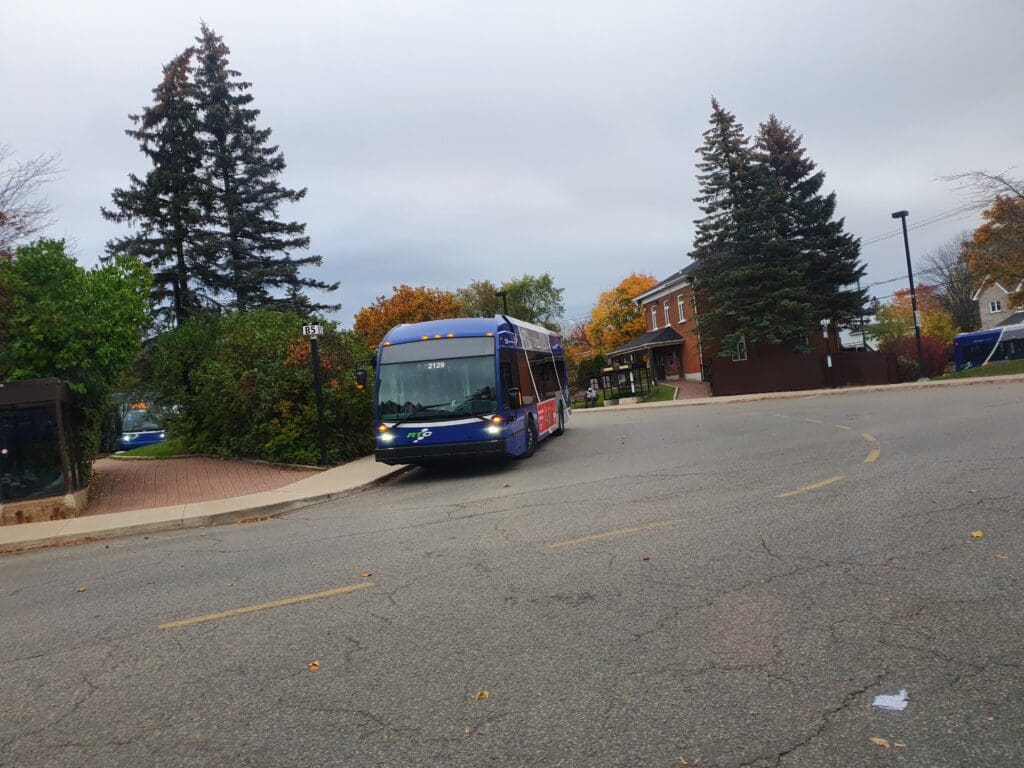
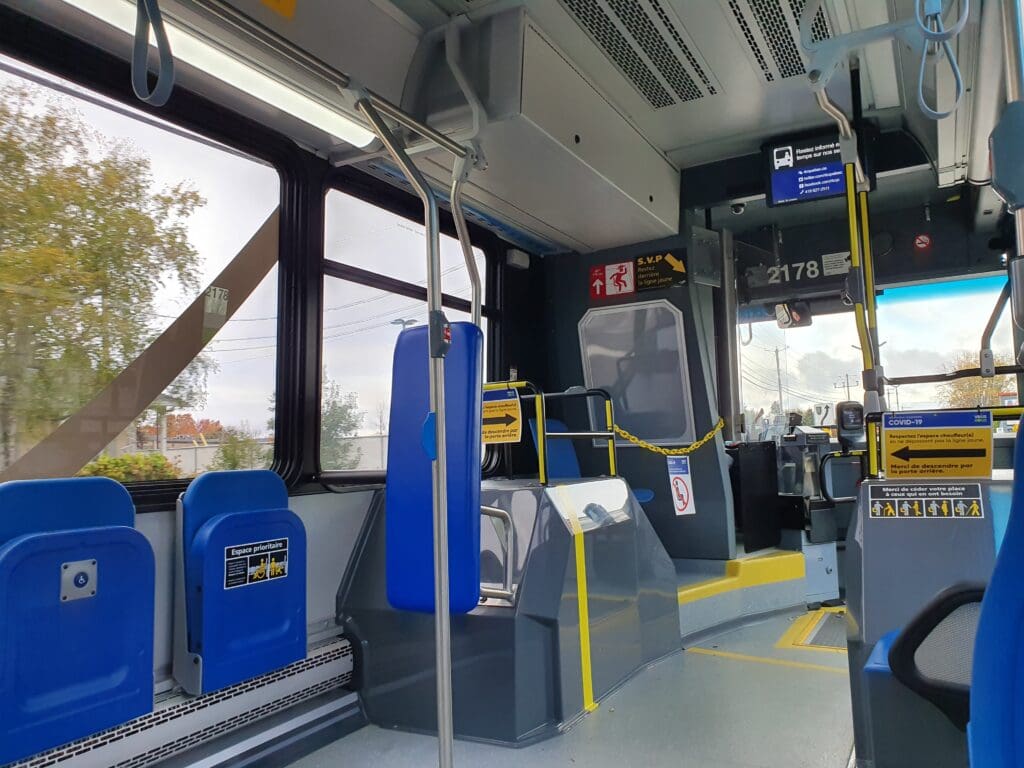
Whilst the bus offers thrifty passengers the cheapest means of reaching the airport, I would not recommend this option to those in a hurry. Both of the two bus services take winding routes through Québec City’s suburbia, making plenty of stops on their journeys to the airport. After stopping at a couple of schools, the bus emptied significantly and as we neared the airport, I was left as the sole passenger remaining onboard. Eventually, a little over fifty minutes after boarding the service, the Québec Government’s fleet of Canadair CL-215 and CL-415 water bomber aircraft came into view and the bus soon took a right down the airport’s long driveway. A short time later, this came to a gentle halt almost directly outside the doors to the terminal’s check-in hall, heralding the end of my trek to the airport.

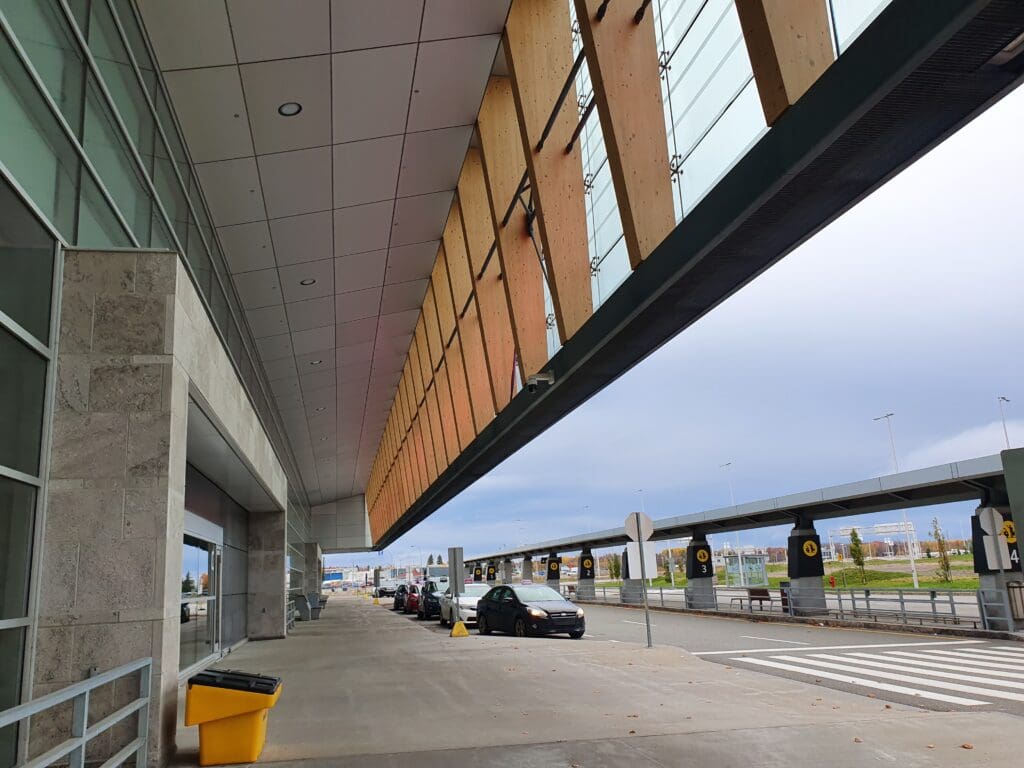
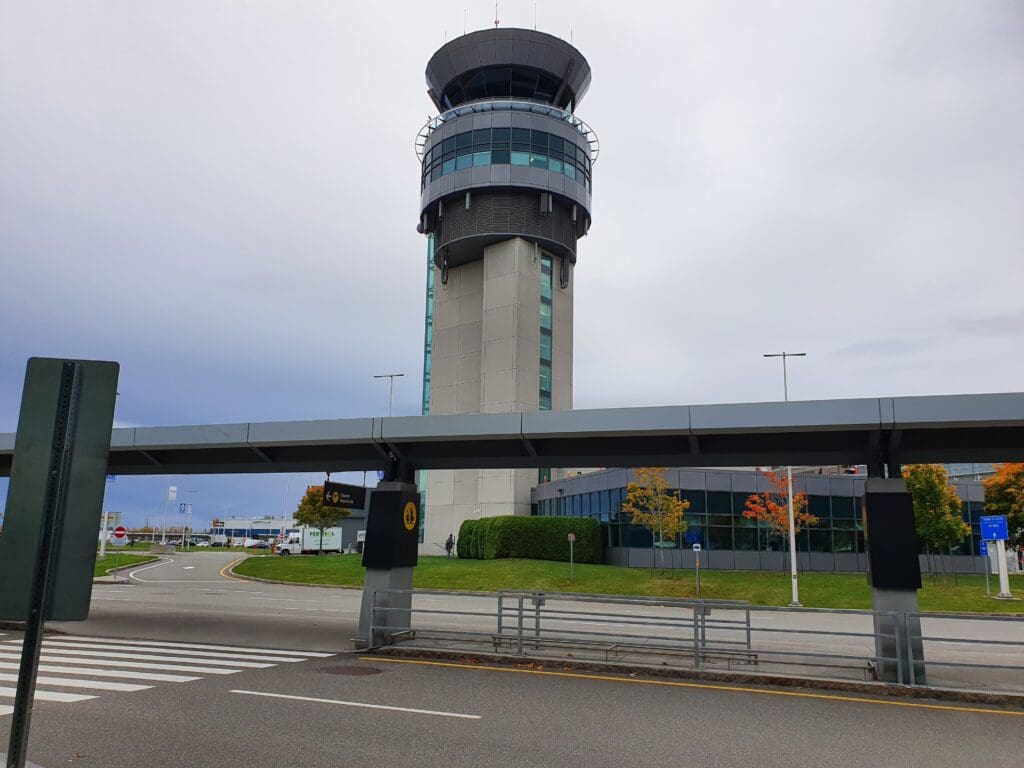
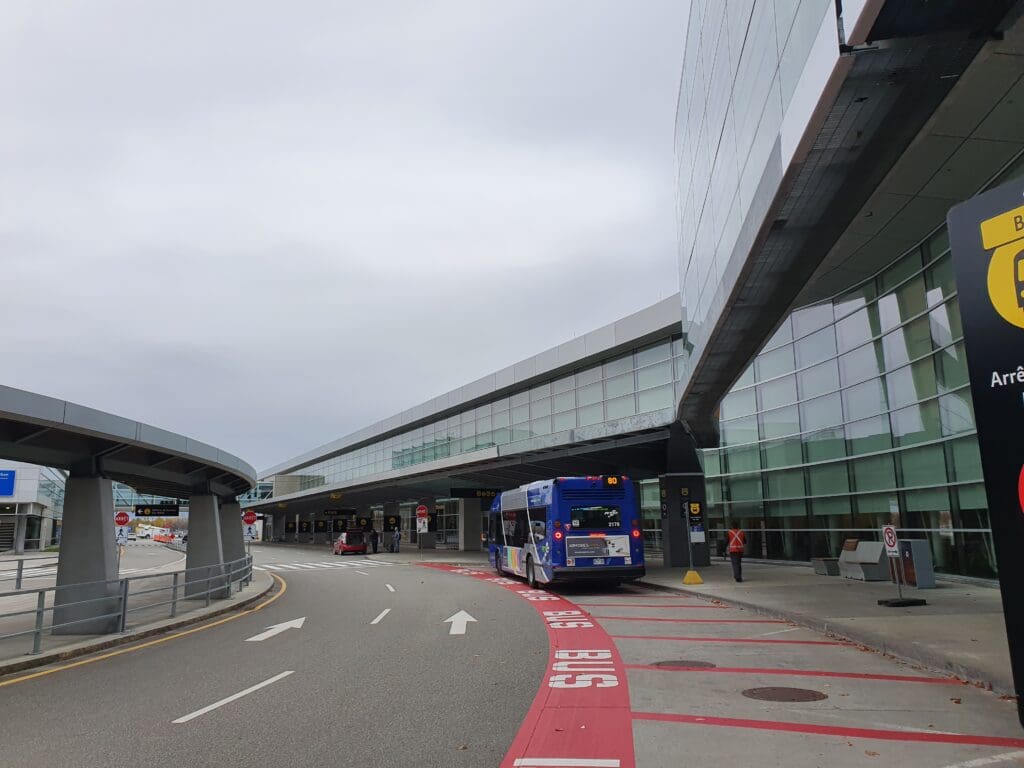
Whilst Québec City Airport has been around since 1939, its current terminal opened its doors in 2008 and was further upgraded and enlarged in 2018. Thus, from both the inside and out, the terminal is modern, stylish and well-designed. Entering the cavernous check-in hall, I found this to be far larger than one may expect given the small number of departures that day, all of which were operated by regional aircraft. However, it was clear that the terminal was designed with international expansion in mind which will hopefully come to fruition as the industry bounces back from the pandemic. Whilst I had checked in online through to Thunder Bay, preferring paper boarding passes I decided to make my way over to one of the many self-check-in machines in the check-in hall. These can be utilised by those departing on Air Canada, American Airlines, United Airlines, Sunwing and WestJet’s services, however, of these airlines, only Air Canada and WestJet maintained services to Québec City at the time of my flight in October 2021. Without any issue, after entering my reservation code my three boarding passes were printed out and with no luggage to check-in, I made my way up the escalators to the security area. To my delight, this was completely devoid of passengers and two checkpoints were open. Walking straight up to one of these, I was greeted in French by a friendly security staff member before my possessions were sent through the x-ray machine and I underwent a full body scan. Within about four minutes of walking into the terminal, I found myself in the airport’s airside departure area.
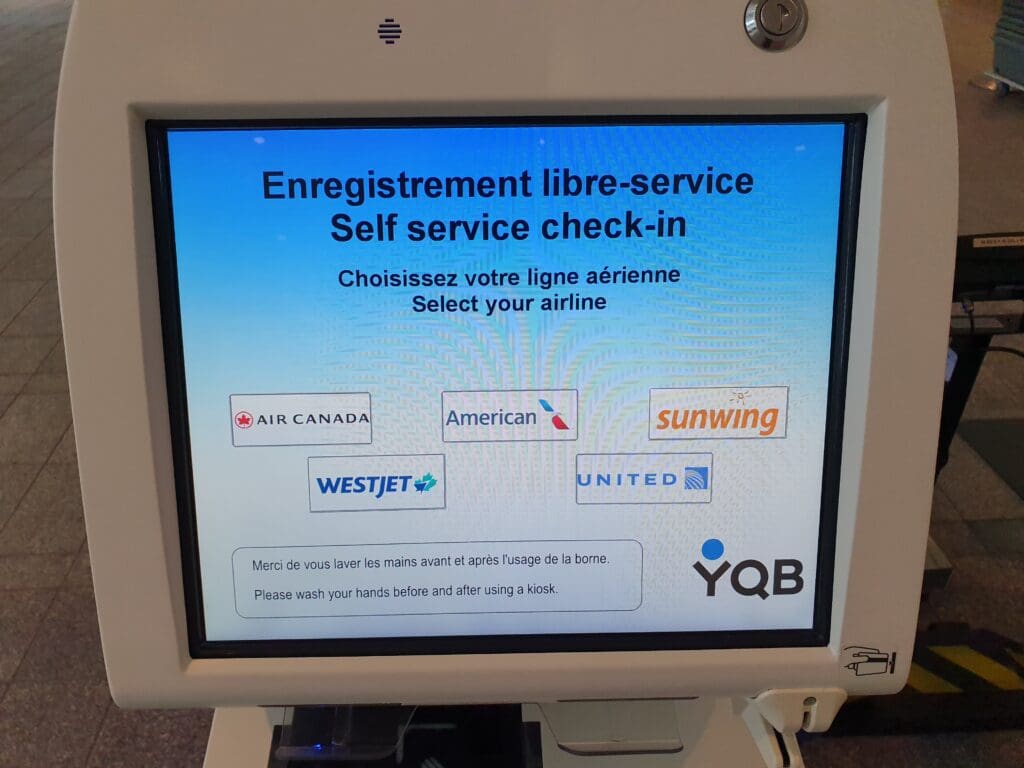
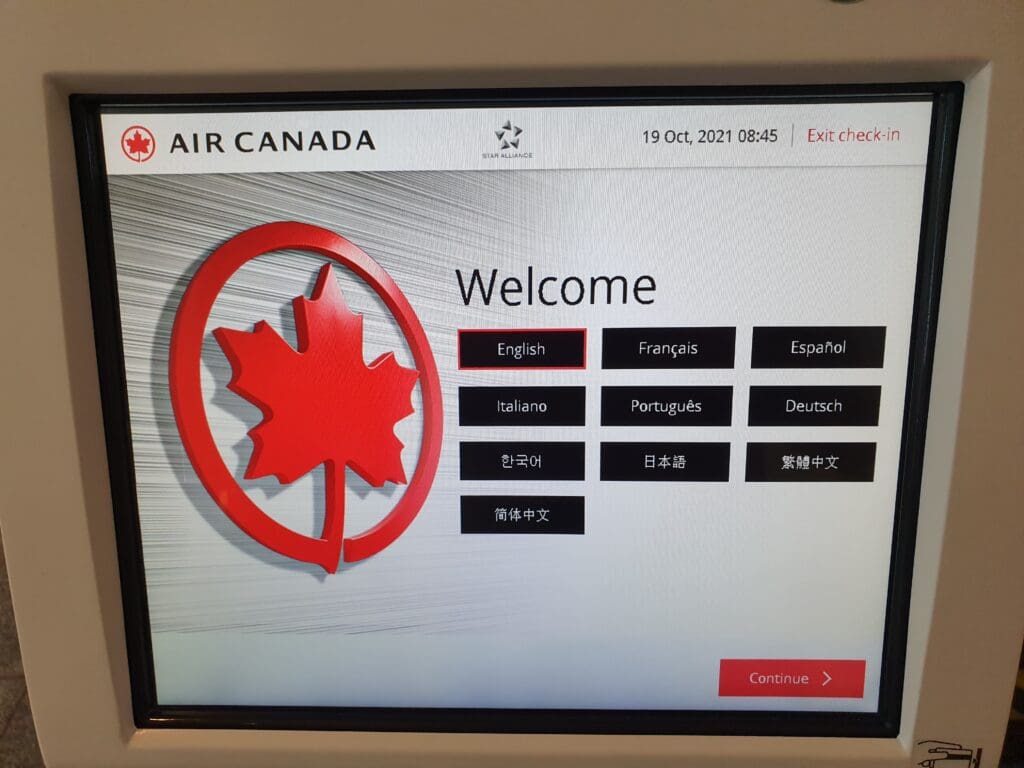
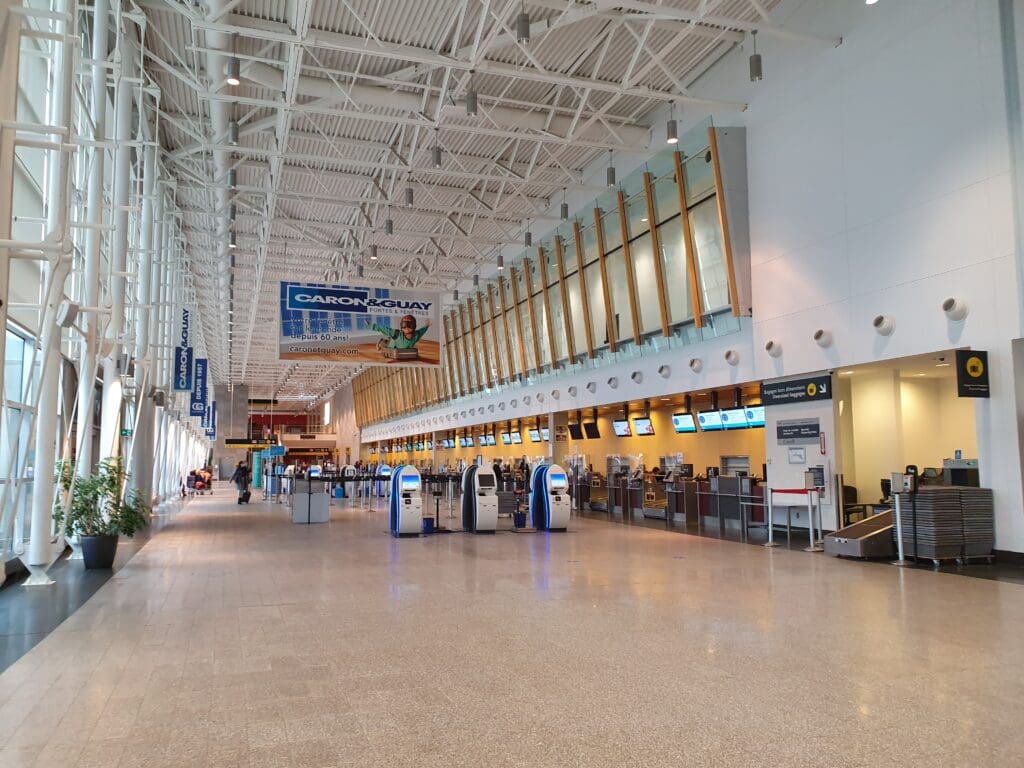
As with the landside area of the airport, the terminal’s large airside area is bright, open, modern and spacious with an abundance of seating – many of which feature built-in plug sockets and USB-A ports allowing passengers to charge their devices whilst waiting for their flights. As many passengers expect in 2021, fast complimentary wifi is offered which I found to work well throughout the terminal for the duration of my stay. In terms of facilities, this terminal is home to several cafes and restaurants, shops and a bureau de change. However, that morning only a single café-bar as well as the local branch of Relay appeared to be open. Aviation enthusiasts will be glad to hear that the terminal offers good vistas of the airport’s two runways as well as gates outside, with many of the terminal’s seating areas serving to be well positioned to allow for the comfortable and easy observation of any movements outside.
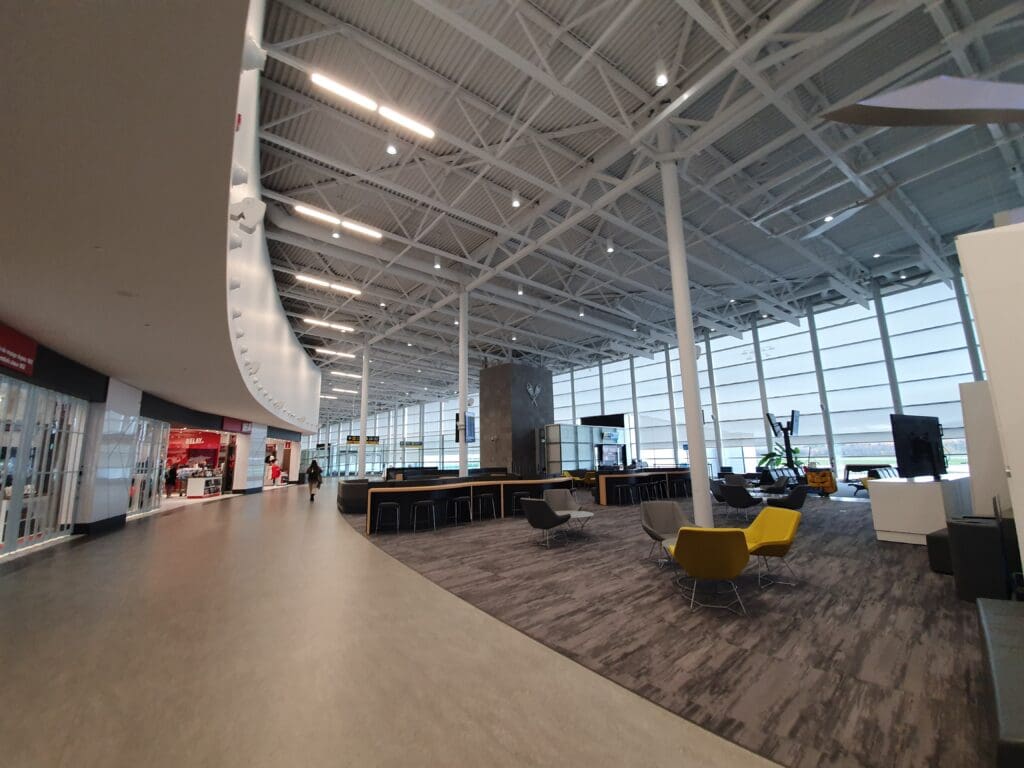
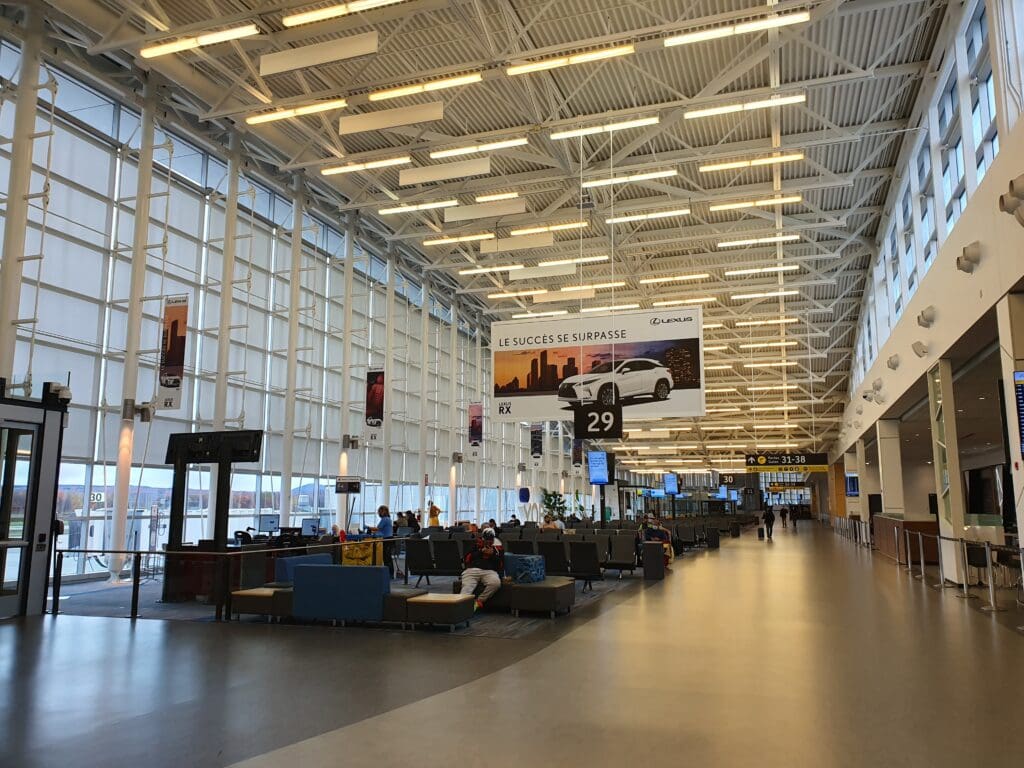
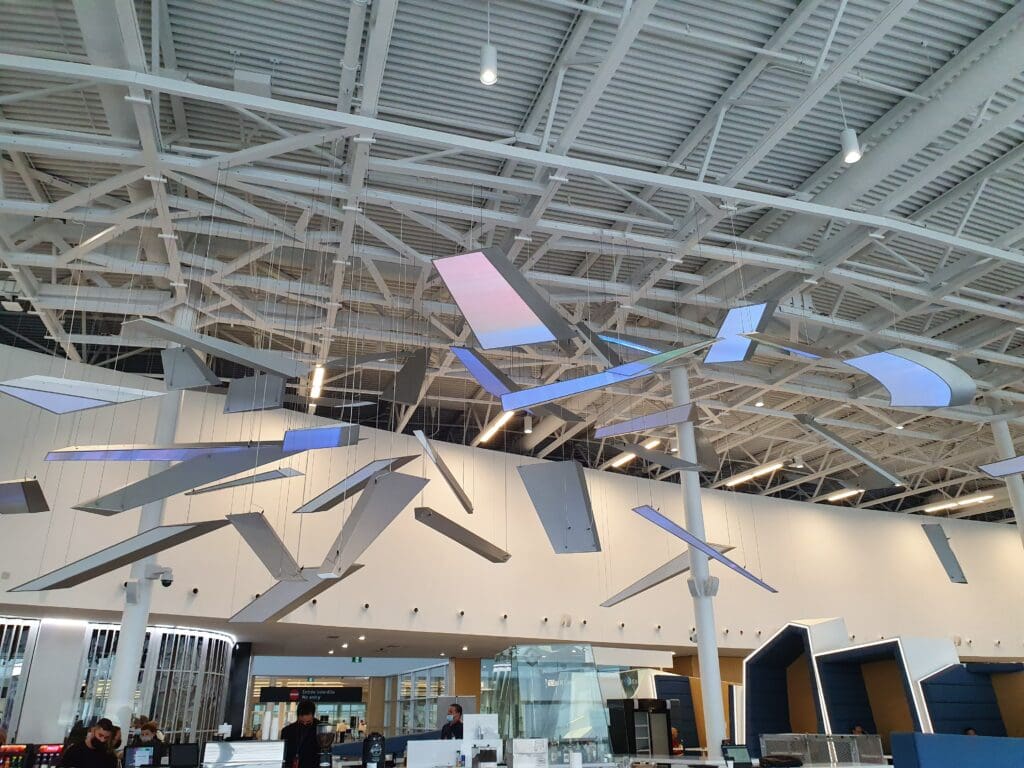

After walking around the terminal for a few minutes, I settled down in one of the many seats that offer a superb view of the apron outside. At that time, a locally based Robinson R44 could be seen practising autorotations on runway 24 – making impressively steep descents before coming to a hover only a short distance above the ground. Other non-scheduled movements included several King Airs and Pilatus PC-12s heading to and from the more remote regions of Northern Québec. Meanwhile on the scheduled side of things, during my wait, a Jetstream 32 and two Saab 340s operated by Pascan Aviation could be seen passing through their airport as they made their way north. Whilst I had wanted to sample a ride on the former during my stay in Québec, my tight schedule and budget had prevented me from doing so, with such flights proving to be rather expensive. Later on, an Air Inuit Dash 8 Q300 popped in for a quick visit during its journey from Montréal to Schefferville and Sept-Iles. This was followed by the largest aircraft to visit during my stay, an Air Canada Express Embraer 175 on a rotation from Toronto. This particular aircraft was the one I would have boarded had I opted for the slightly quicker one-stop itinerary from Québec City to Thunder Bay.
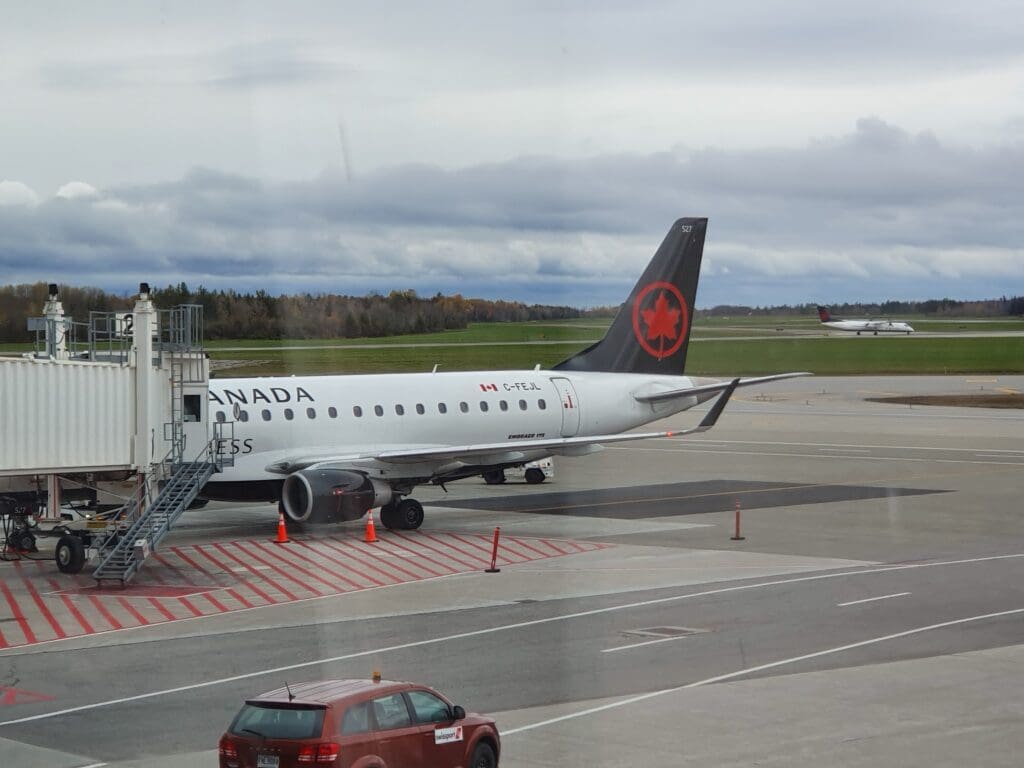
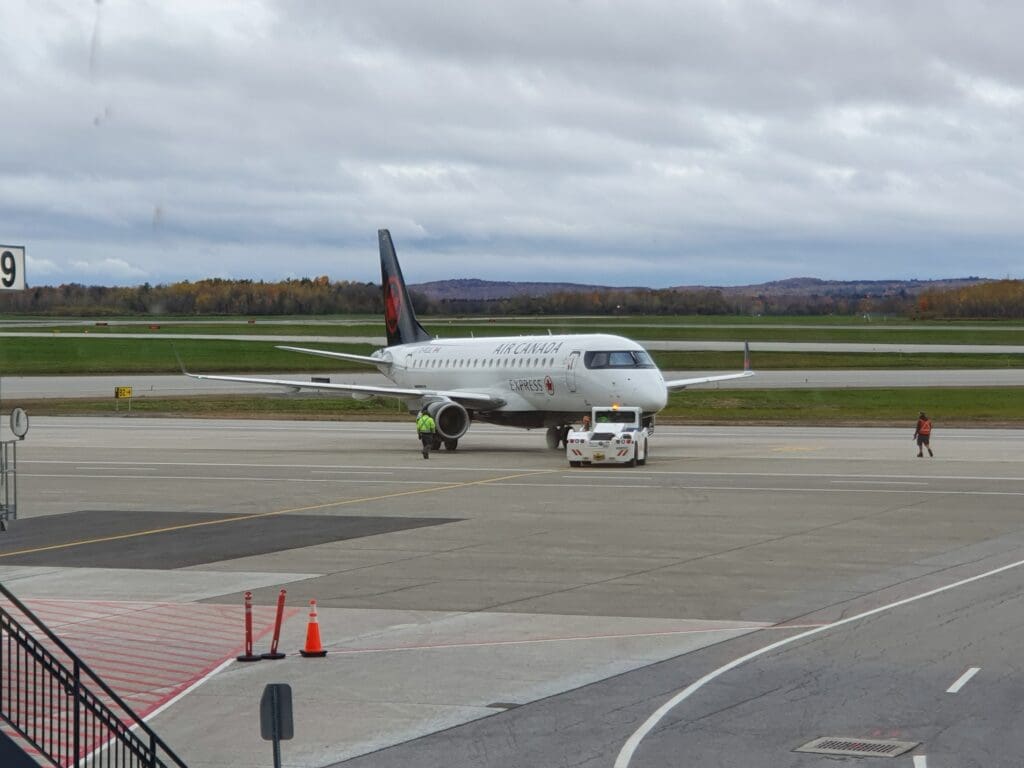
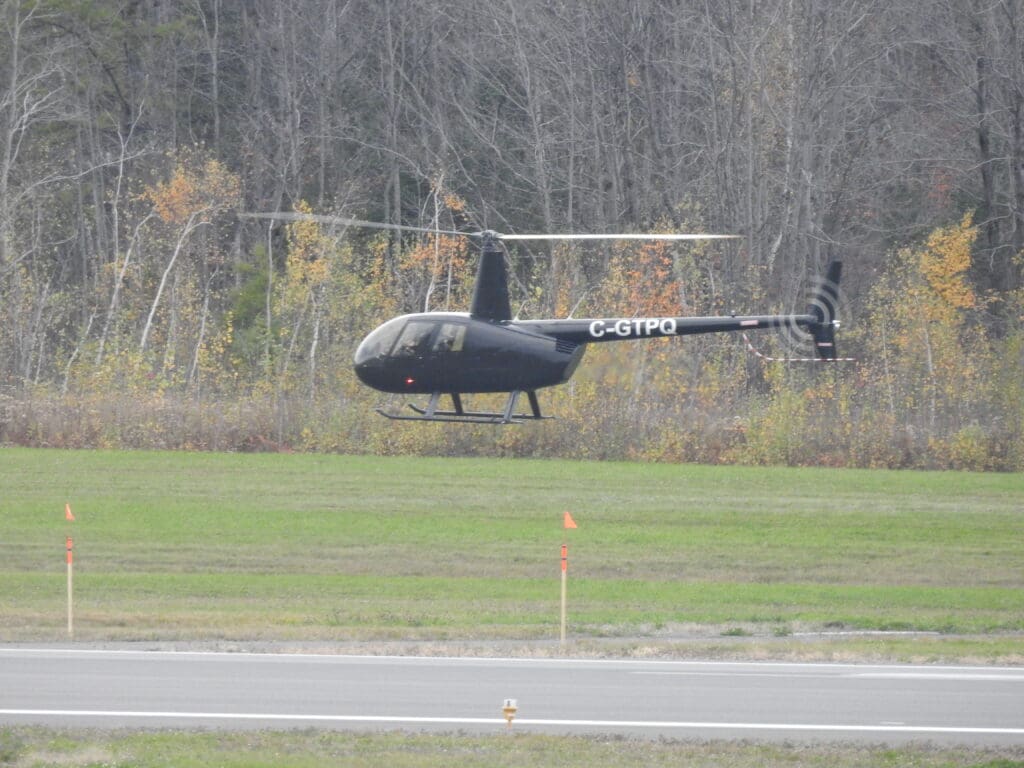
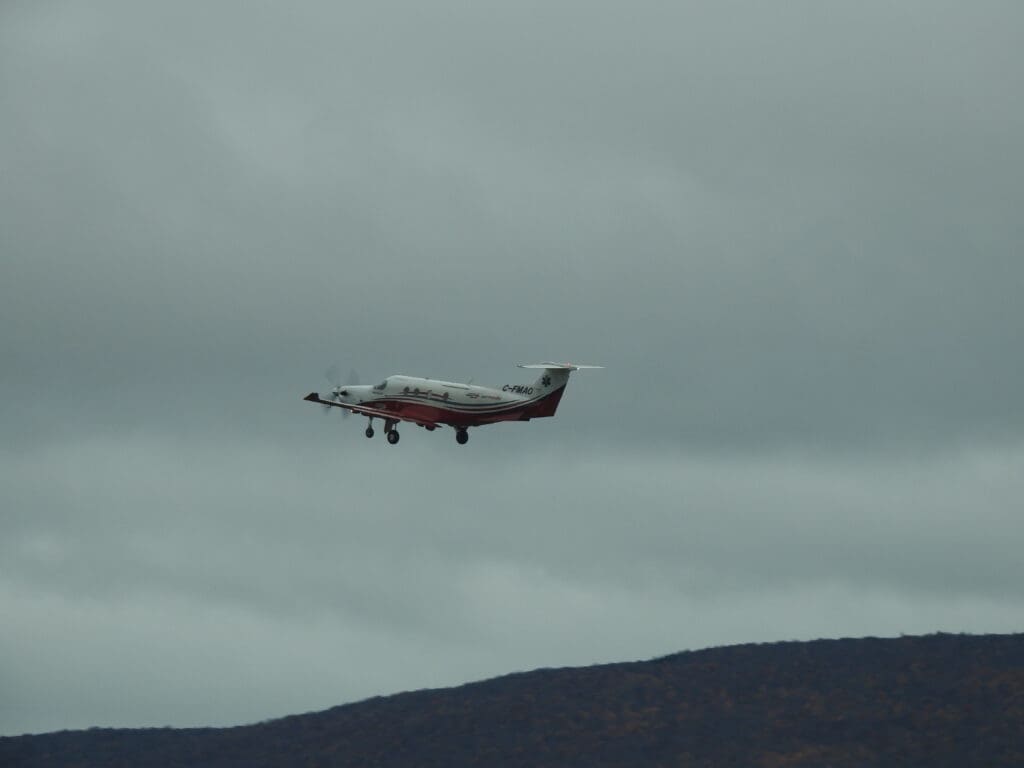
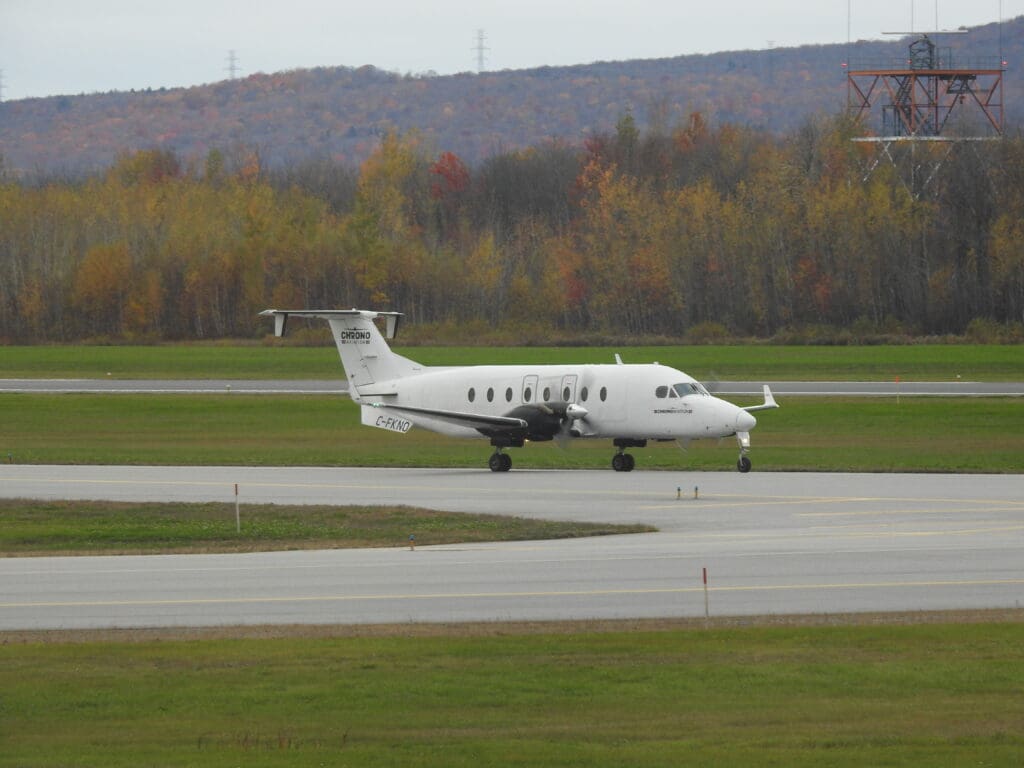
With plenty of time before my flight, at 1001 the pencil-like Dash 8 operating the flight down to Montréal touched down in Québec City and made a short taxi over to stand 25. This particular aircraft took the form of C-GKUK, a Jazz Aviation-operated Air Canada Express Bombardier Dash 8 Q402 with the fin number 402. As with all Dash 8s, this particular aircraft was manufactured at Bombardier’s facility at Toronto Downsview Airport and delivered to Jazz Air in June 2011. As you may expect, this was delivered with Air Canada Express’ old ‘toothpaste’ livery before receiving the carrier’s new livery in early 2018, around a year following this scheme’s introduction. Since 2011, this Dash 8 has spent its career hopping across Canada, connecting large hubs with smaller regional airports throughout the country, and according to the AvHerald has experienced several incidents. The first of these occurred in 2012 when the aircraft was forced to land without its flaps extended in Moncton, meanwhile, in 2015 low oil pressure indications resulted in the pilots shutting down the right-hand engine and diverting to Ottawa on a flight from Toronto to Fredericton. More recently, in July 2020 smoke in the aircraft forced this to return to St John’s on a flight to Halifax and finally in April 2021 the aircraft experienced trouble with the landing gear indicator lights and thus returned to Toronto on a flight to Thunder Bay. Based in Montréal, in the week before my flight, the aircraft had connected Québec’s largest city with Ottawa, Québec City and Toronto City Airport.
According to my boarding pass, boarding for the morning flight down to Montréal would commence thirty minutes before departure at 1045 so several minutes before boarding I began the walk over to Gate 25. Upon arriving there, a reasonable selection of passengers could be seen waiting for boarding to commence and a new crew could be seen heading out to the aircraft. As on the other Air Canada flights that I have taken, before boarding was announced an automated announcement rang out from the gate podium advising that boarding would take place per the zones printed on passengers’ boarding passes, and those on the flight were advised to have their documents ready for inspection. At 1043, boarding commenced with those in Zone 1 invited to proceed forward for boarding, quickly followed by those in Zones 2, 3 and 4.
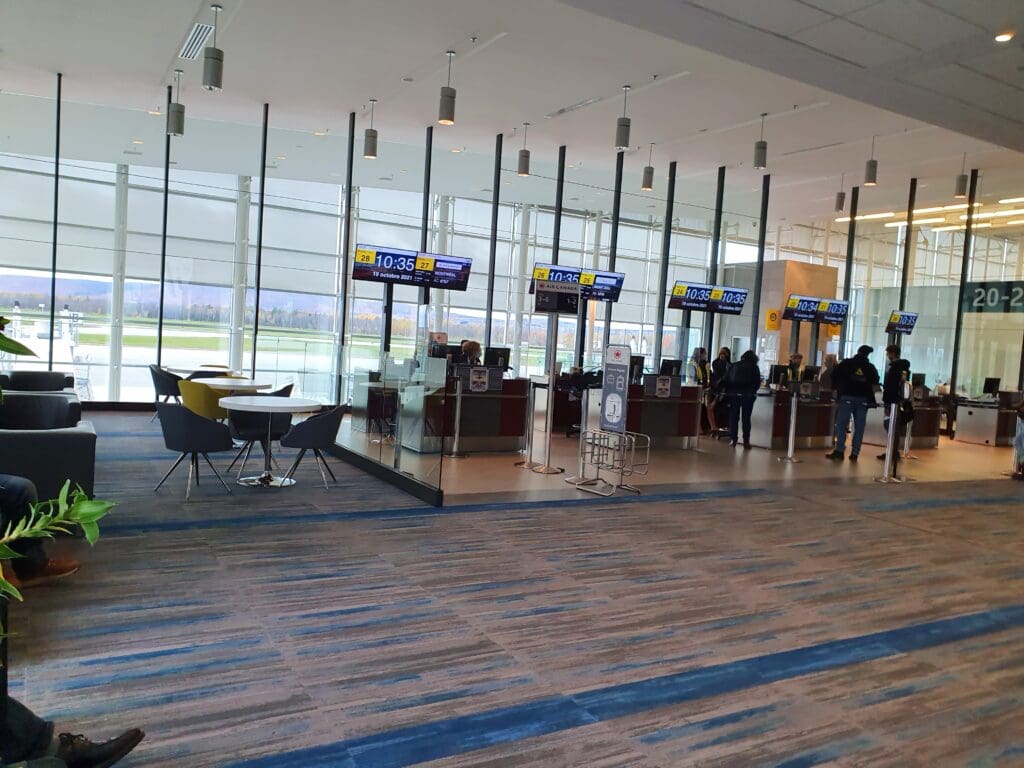
No more than three minutes after the commencement of boarding, my boarding pass was scanned and my passport was checked by the gate agent before I made my way down the escalators to ground level. Following a quick walk along a corridor, I was directed by another Air Canada agent to take a right and head up a snaking jetbridge. Whilst boarding small regional aircraft via jet bridges is rather common in North America, this was my first ever time boarding such a small aircraft through a jet bridge and it was a slightly novel experience.
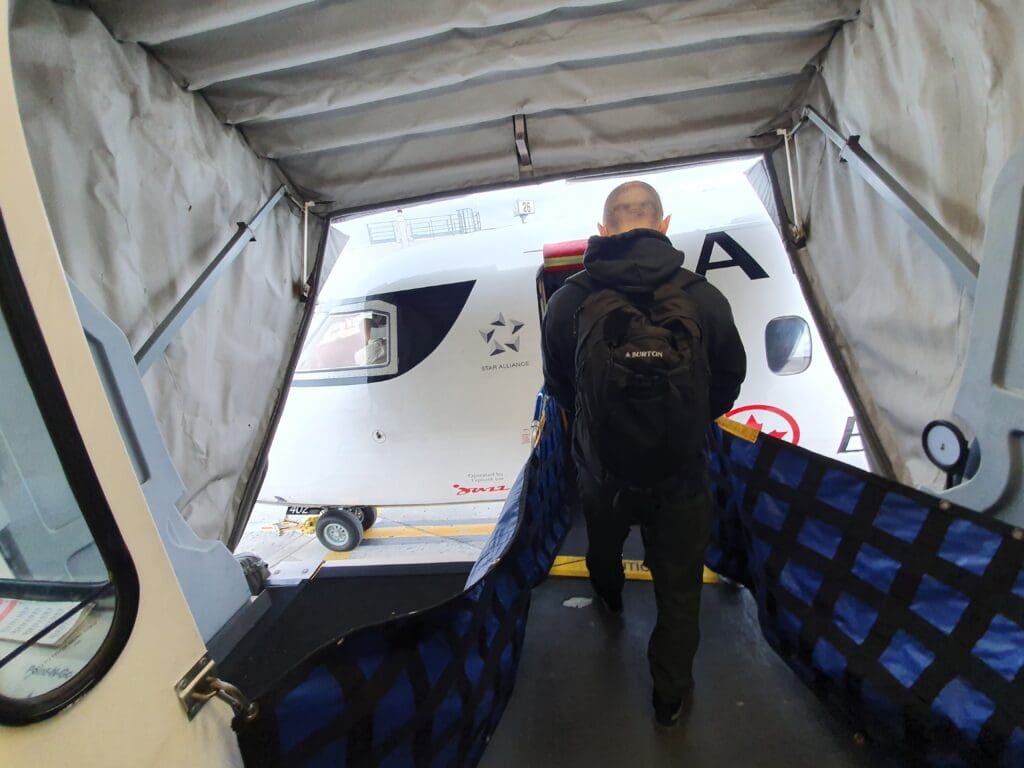
A short time later, I cautiously walked across the narrow gangway, taking care not to bang my head as I made my way into the Dash 8. As soon as I entered the cramped forward galley area, I was greeted in French and handed one of Air Canada’s CleanCare+ kits – this contained a disposable mask, three wet wipes and a message from the airline’s chief medical officer. Whilst getting to the aircraft had been quick, once inside the cabin, it took some time to shuffle down the narrow aircraft to Row 16 as passengers wrestled with their luggage in an attempt to squeeze this into the Dash 8’s seemingly small overhead lockers.
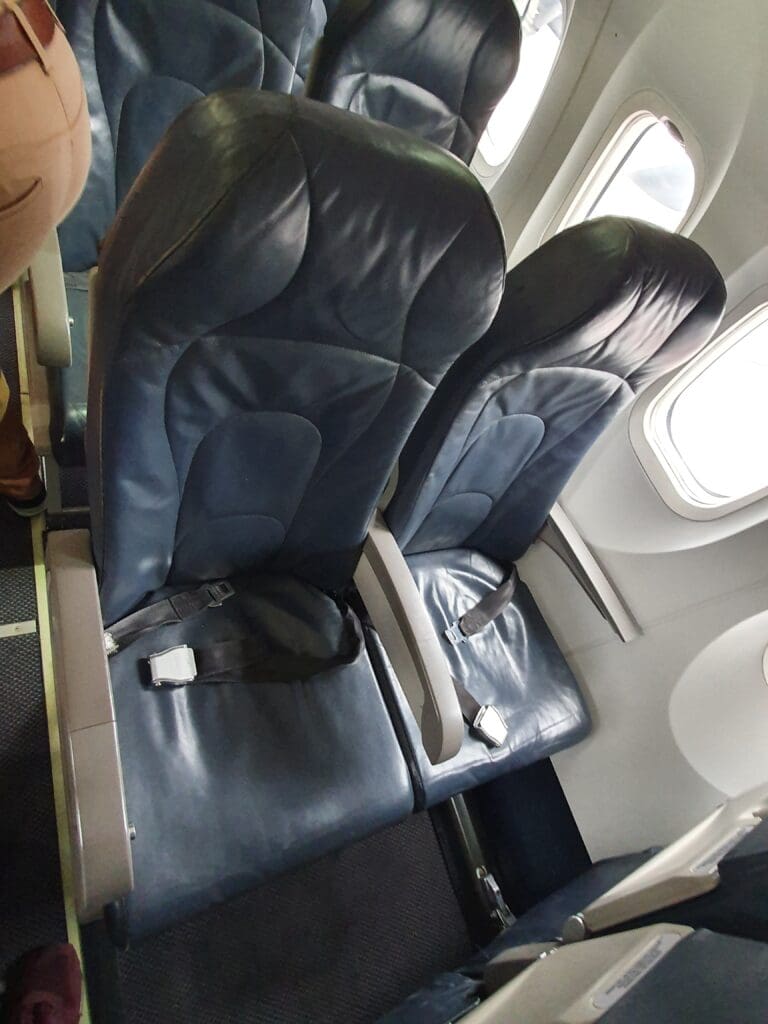
Onboard, as with all Air Canada Express Dash 8 Q400s, C-GKUK features 74 seats in an all-Economy configuration. Unlike the slimline seats of today, these seem to be rather chunky in appearance and are covered in a (faux?) dark blue leather covering. Upon taking my seat, I was happy to find that these seats were as well padded and comfortable as they appeared, offering a somewhat standard amount of legroom for a regional turboprop. However, examining my seat and the area around this, it was clear that the aircraft’s cabin had seen better days, with a fair few stains, scratches and marks visible in the area around my seat. Furthermore, whilst the cabin had appeared clean at first glance, upon lowering my tray table later on during the flight, I was not all too impressed to find a good number of crumbs remaining on this. Finally, turning to the seat back pocket, this contained a safety card as well as a paper Air Canada branded sickbag.
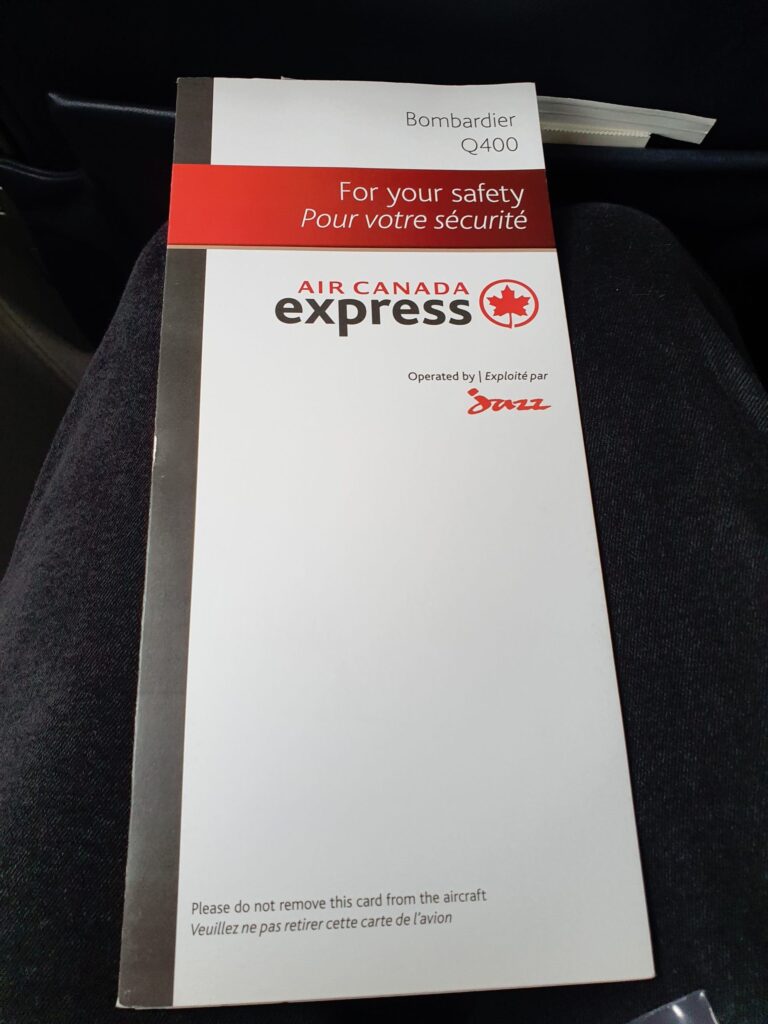
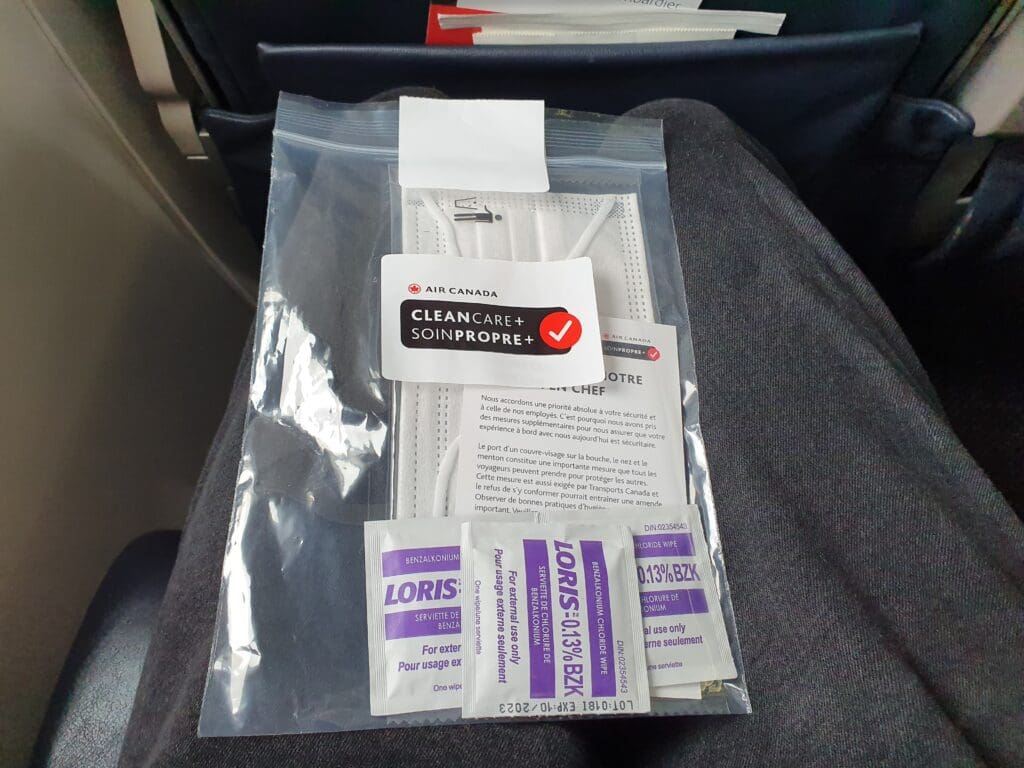
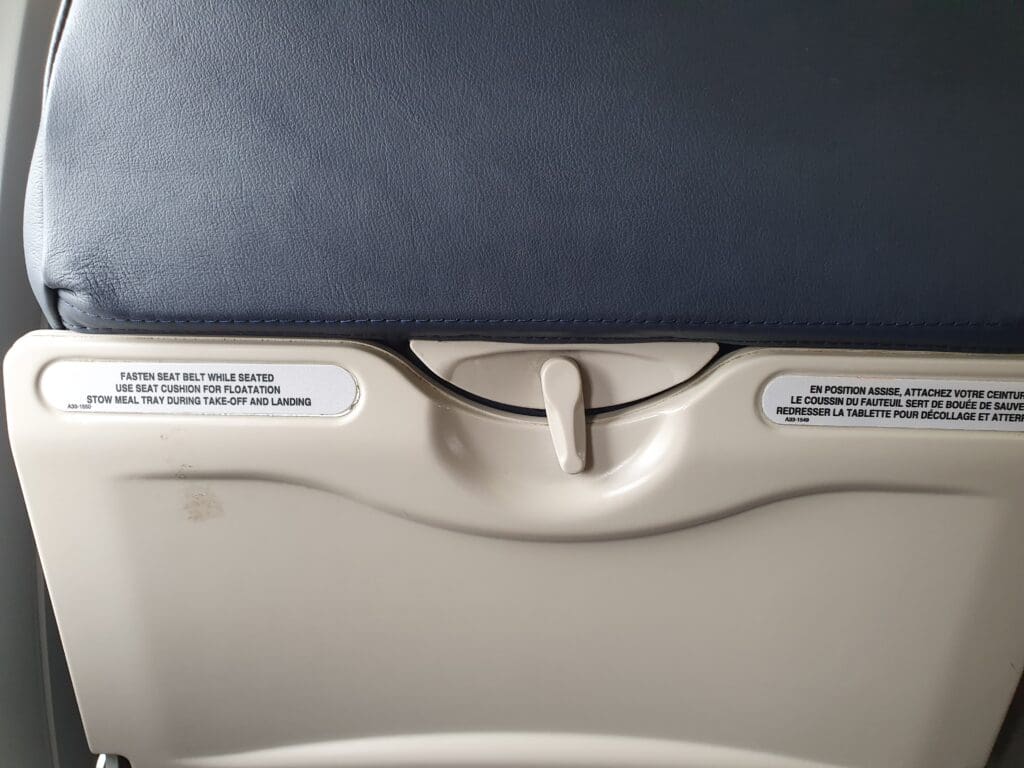
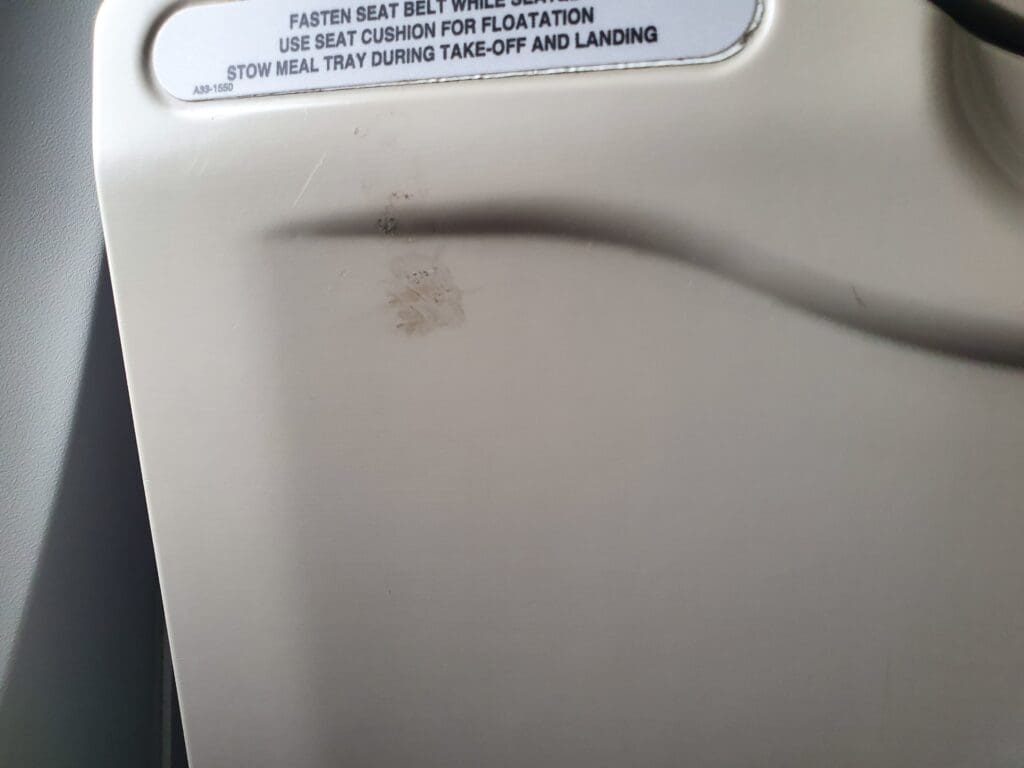

That morning, all passengers had managed to make it to the aircraft in good time and boarding was announced as complete at 1058, well ahead of the flight’s scheduled 1115 departure time. Heading down to Montréal, I would estimate the flight to have been around 70% full and I was lucky enough to enjoy a vacant neighbouring seat for the short ride south. With many passengers onboard speaking English, and overhearing the conversations of several others, it seemed like a good number of those heading down to Montréal were connecting onwards to destinations across Canada. Once boarding had concluded, the Captain performed a welcome announcement in French and then again in English, welcoming all onboard, notifying all of our 30 minute flight time and 20,000 feet cruising altitude, providing an overview of the route and ending this with a word on the weather in Montréal.
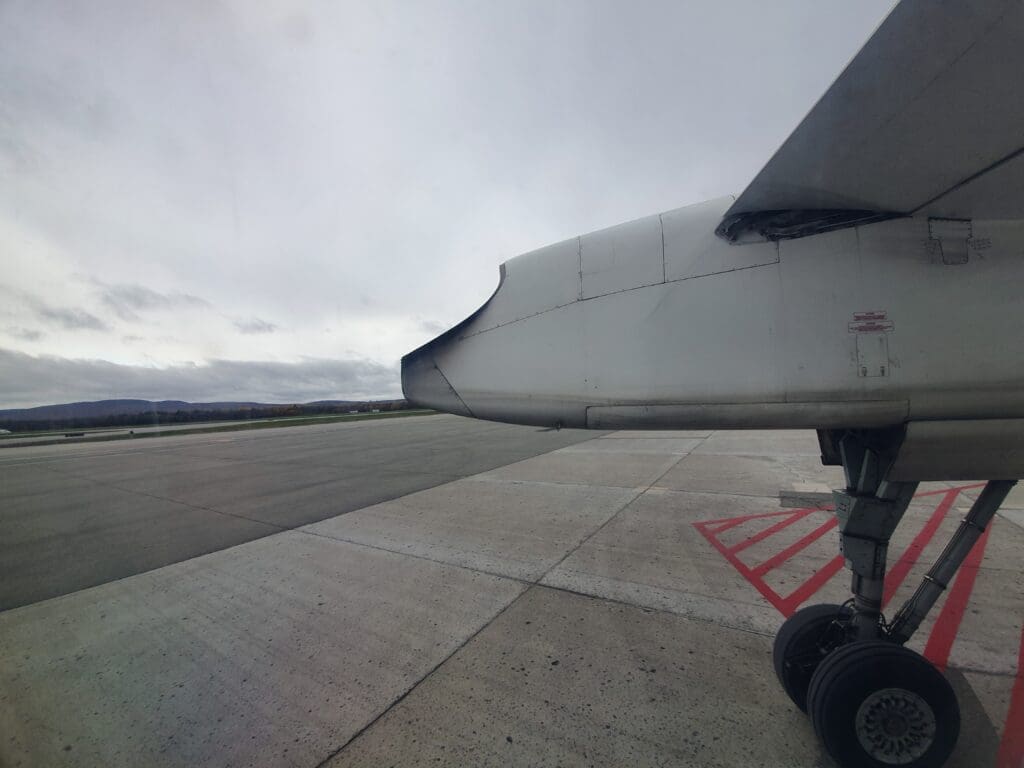
Well ahead of schedule, at 1103 the propeller on the starboard side of the aircraft began to whirl and the main cabin door was soon closed. This was followed by a welcome announcement from the Services Director during which the aircraft began to be pushed back away from the stand, with a pre-recorded safety announcement then played with the two crew members undertaking a demonstration in the aisle. Once the tug had been disconnected, the turboprop began a short taxi over Runway 29, the shorter of Québec City Airport’s two runways but still more than long enough for a Dash 8 Q400. During this taxi, the crew passed through the cabin ensuring all was in place for our departure before strapping themselves into the jump seats.
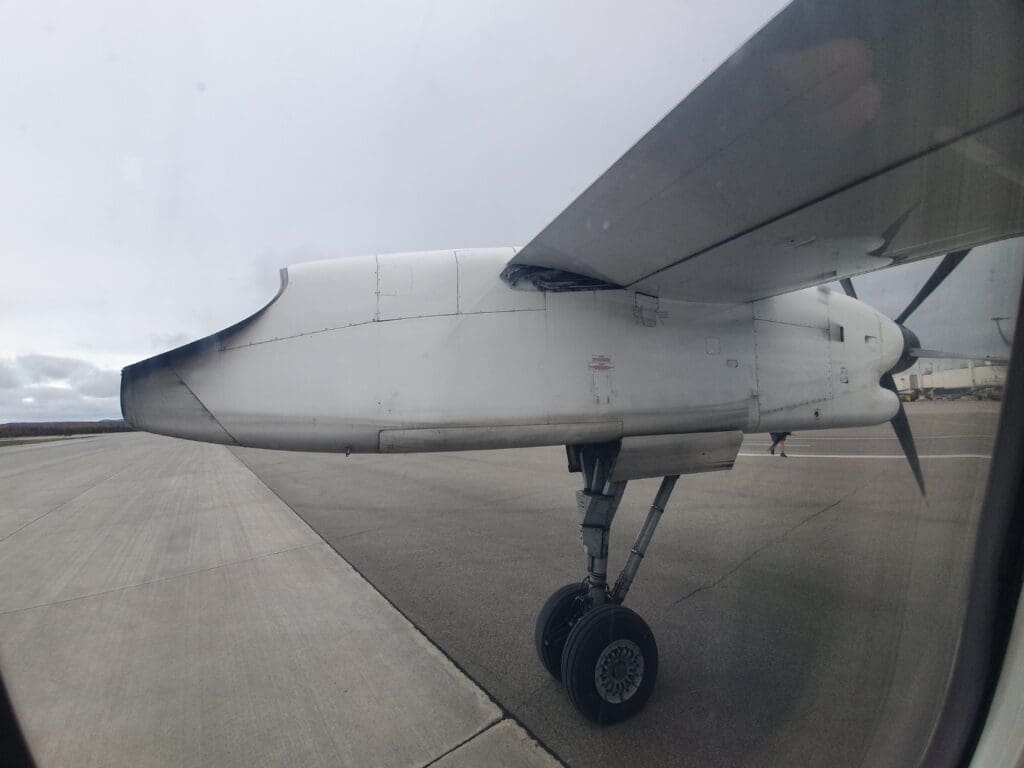
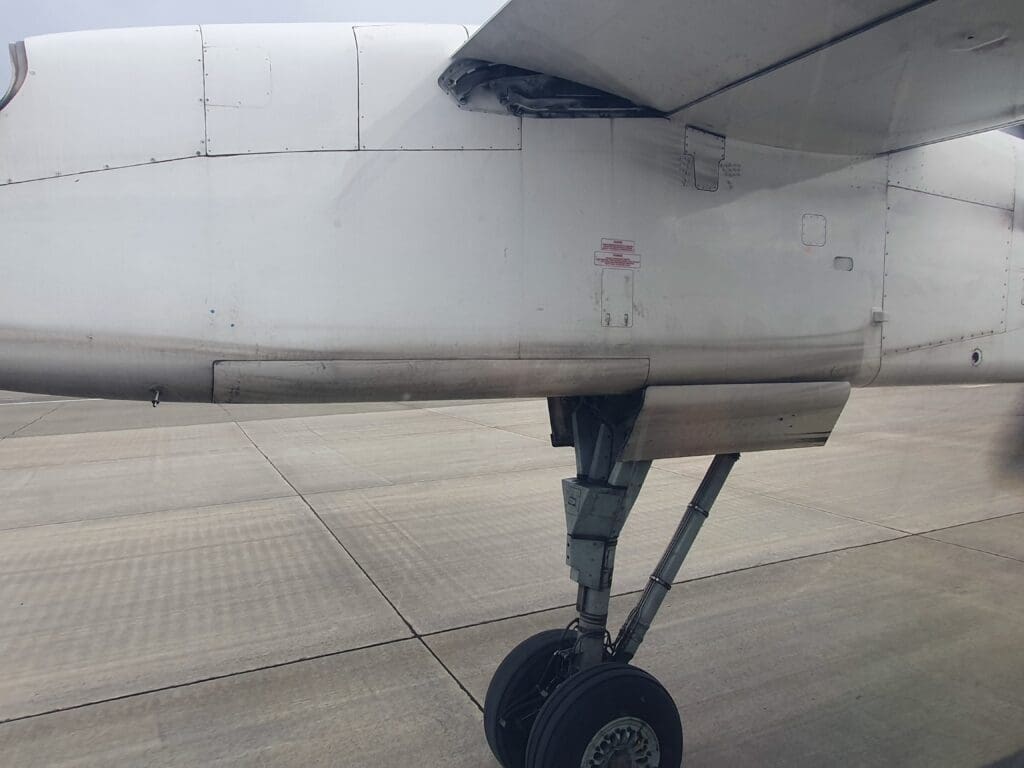
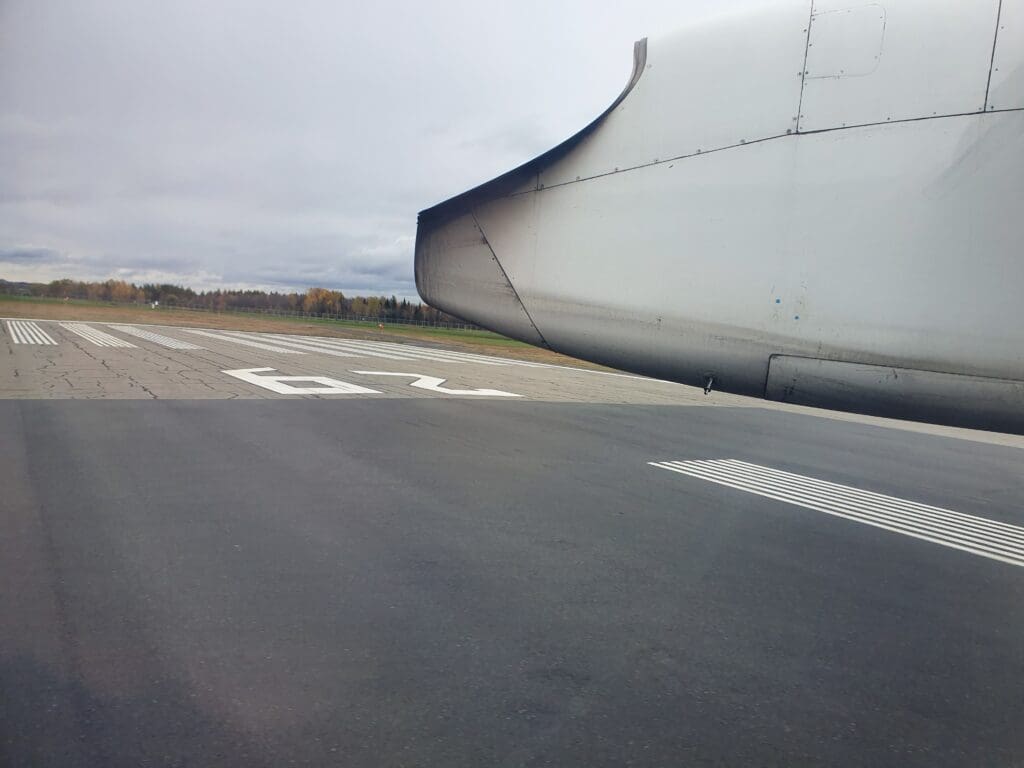
After passing a collection of hangars outside of which a diverse smorgasbord of aircraft ranging from Cessna 150s to a Learjet 45 could be seen, two loud dings rang out through the cabin and at 1113 the Dash 8 taxied onto the runway and commenced a powerful rolling takeoff. Once up in the skies, the aircraft’s landing gear was soon retracted and the aircraft climbed over the mostly flat and picturesque rural landscapes to the south of Québec City – these consisted of large rectangular fields and the occasional bank of autumnal brown, orange and red trees for which this part of the world in somewhat known.
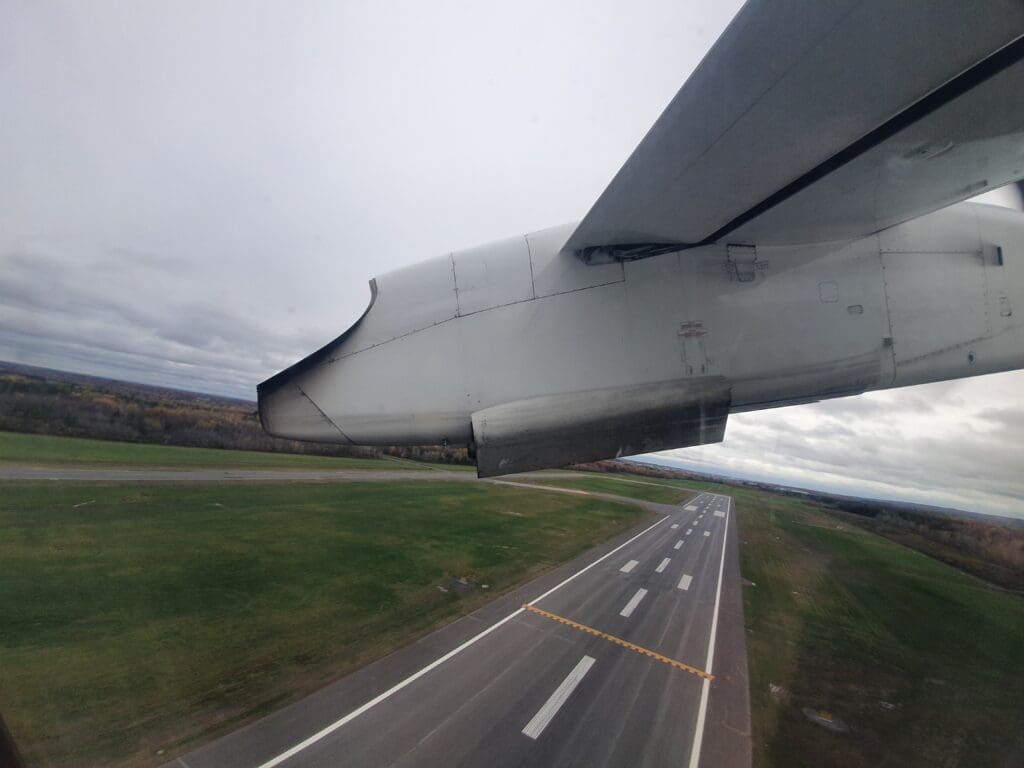
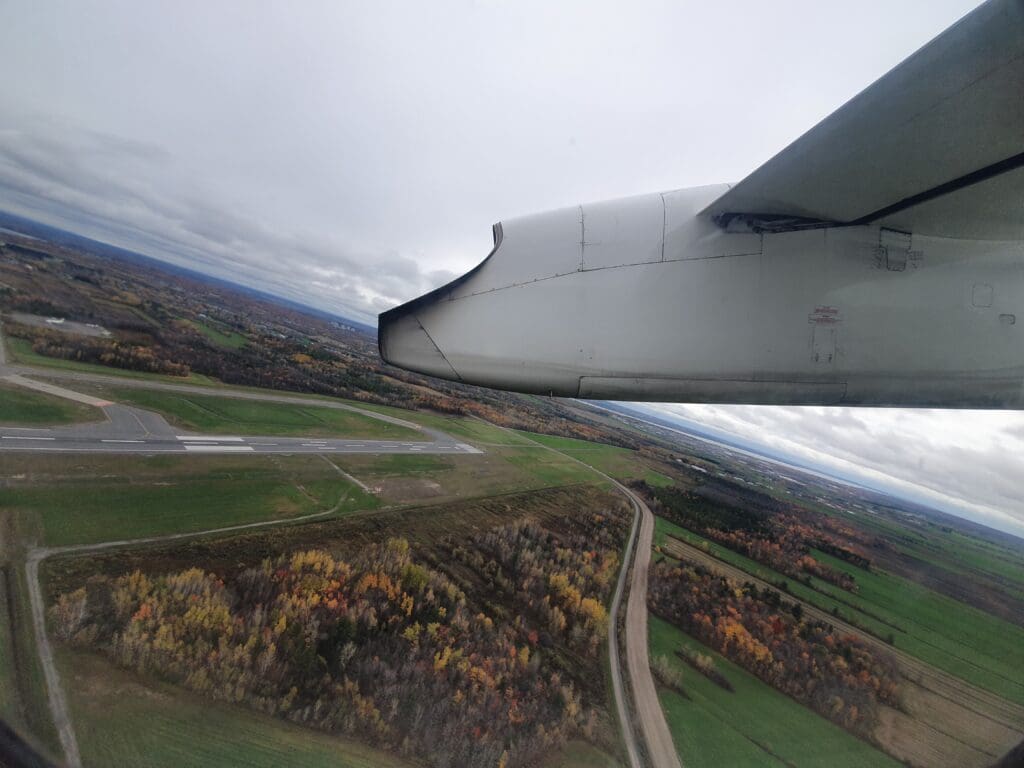

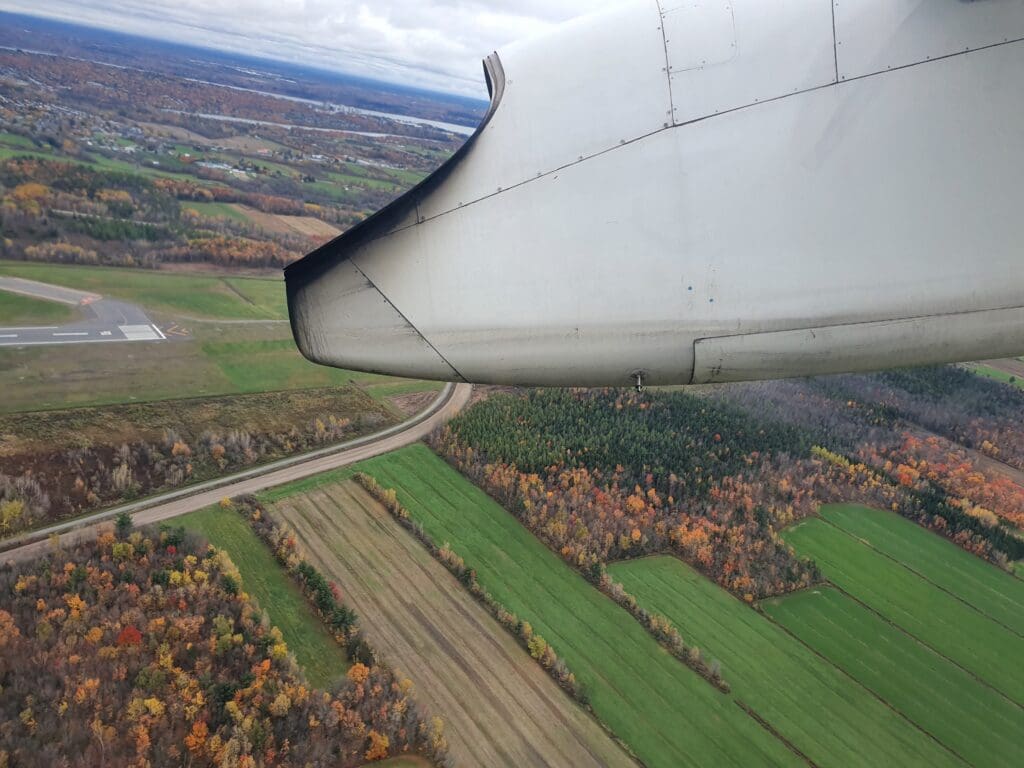

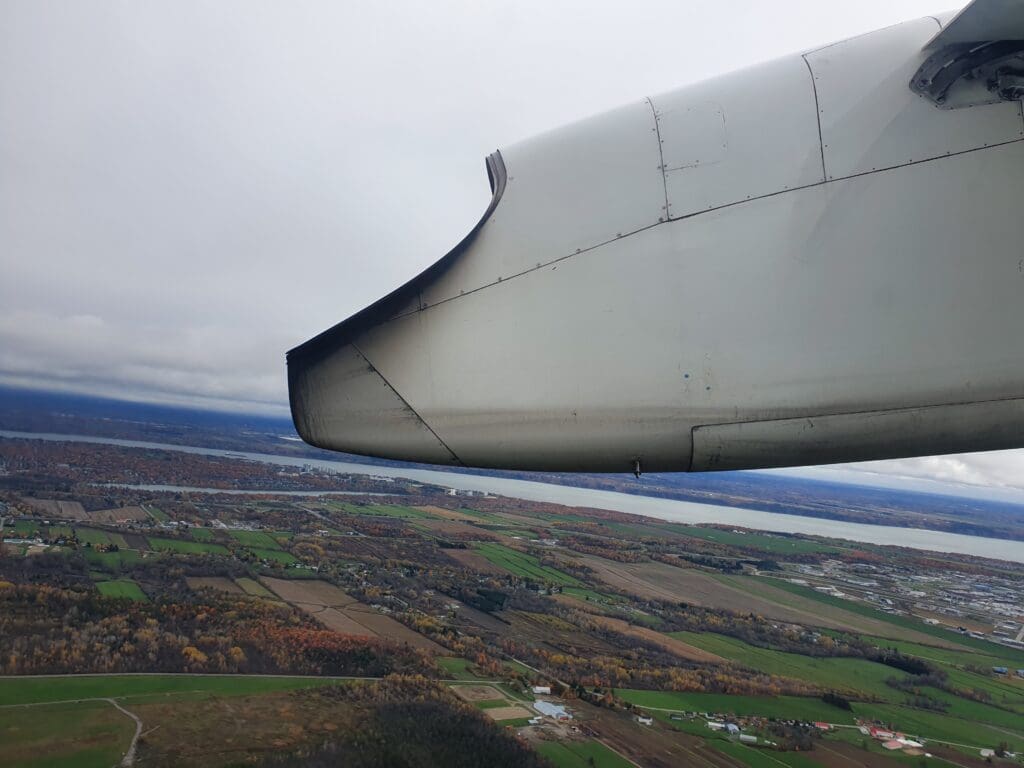
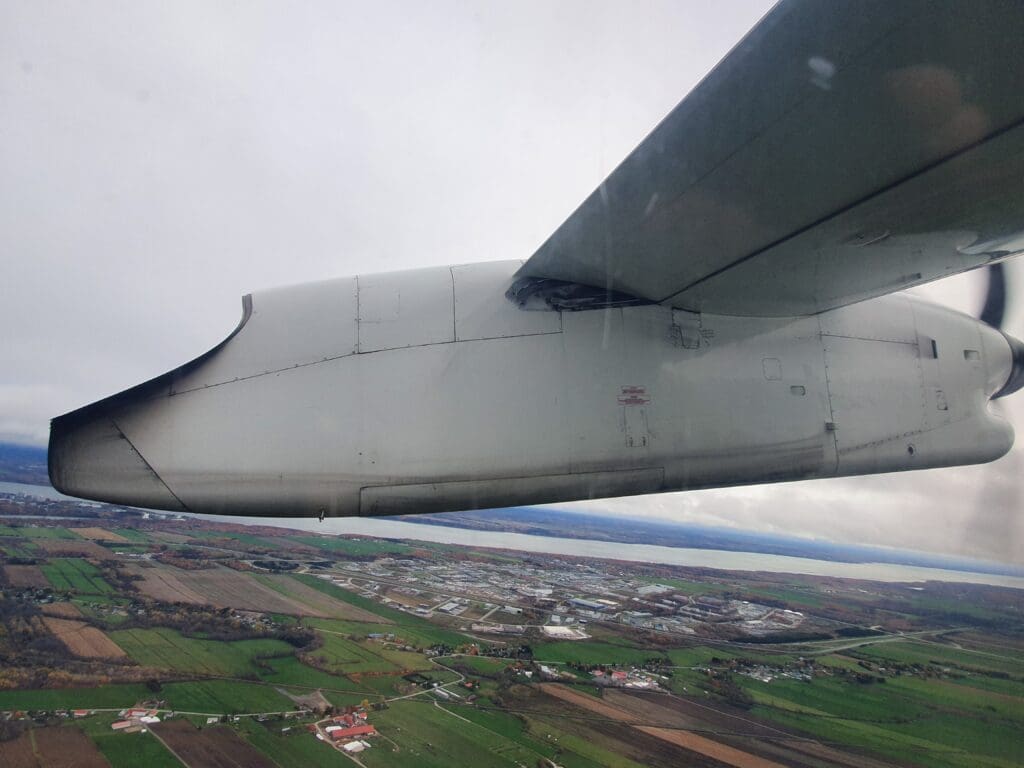
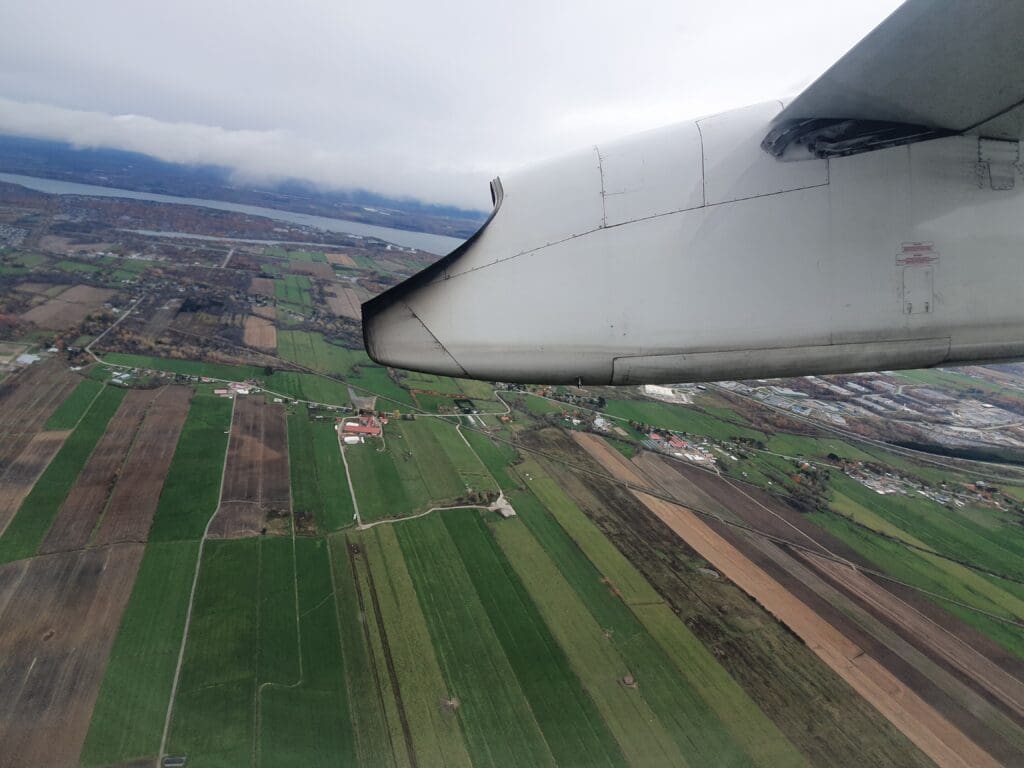

After skirting around the large industrial estate at Saint-Augustin-de-Desmaures, the Dash 8 crossed over the St Lawrence River and a minute or so later low lying clouds swept in below preventing any decent views of the Québec landscape. Once released from their seats, at 1123 the two crew members rolled out a trolley to the front of the cabin indicating the commencement of the inflight service. Meanwhile two minutes after this once the Dash 8 had reached its cruising altitude of 20,000 feet, the seatbelt signs were switched off although unsurprisingly most remained in their seats.
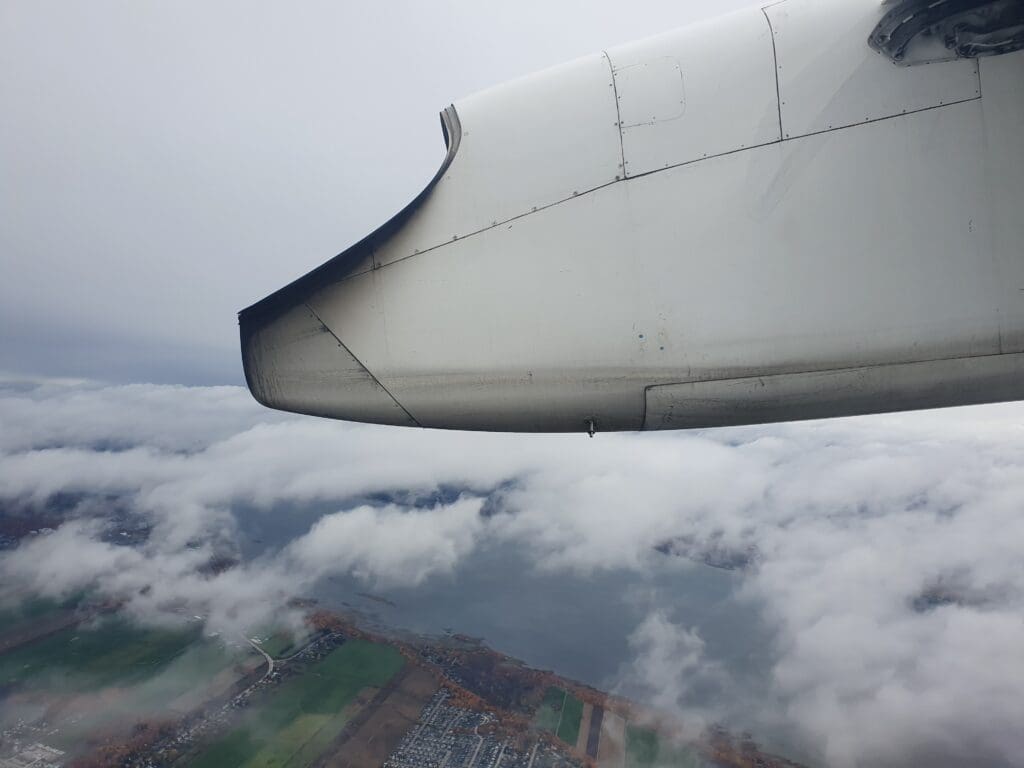
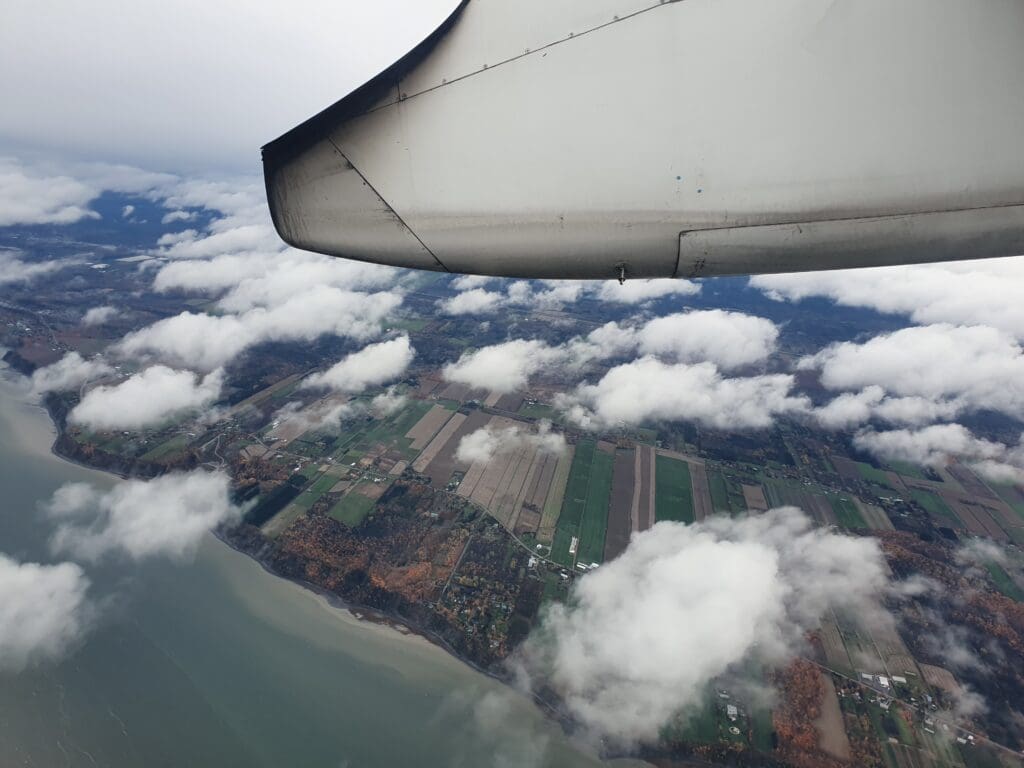
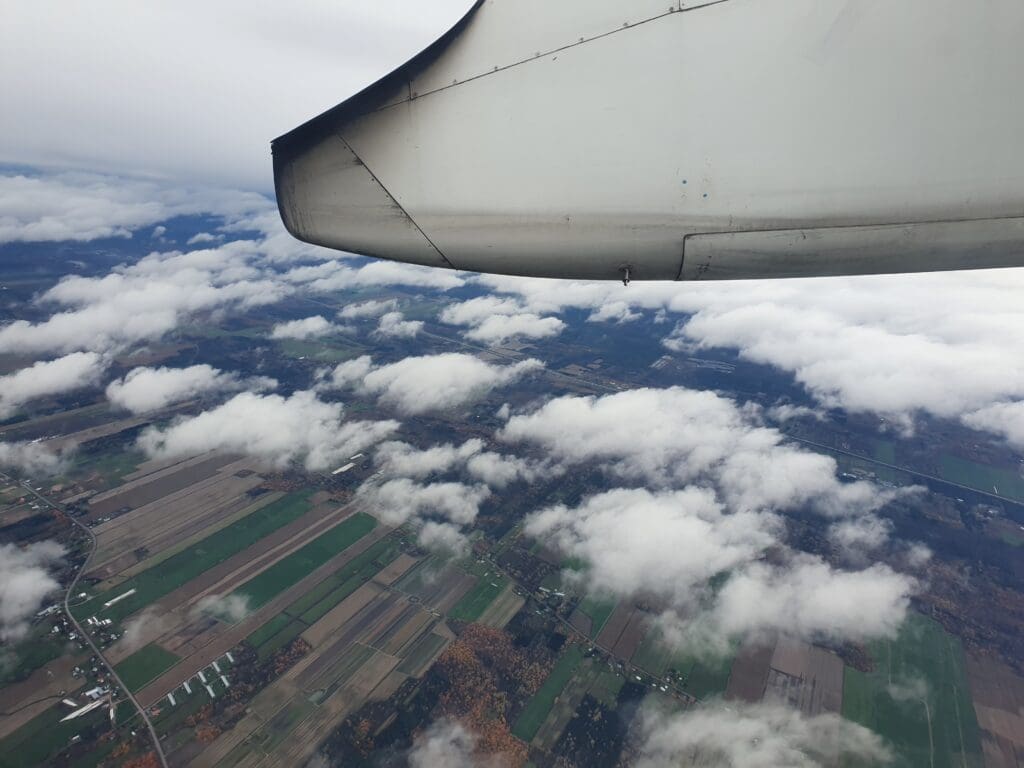

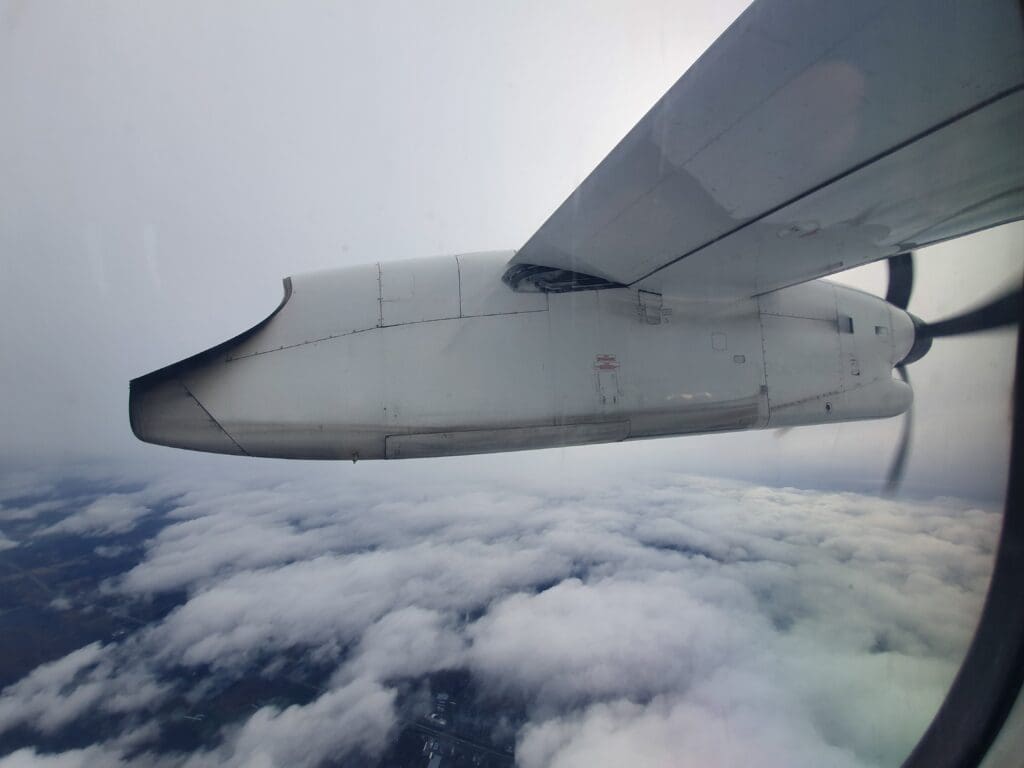
Given the short flight time down to Montréal, the crew were forced to work as efficiently as possible and appeared to make their way through the cabin rather quickly. Several minutes after this service commenced, I was asked for my choice of drink by a fairly friendly flight attendant. Opting for an orange juice, this was handed to me in a carton along with an Air Canada branded serviette and a packet of pretzels. Whilst this was by no means the pinnacle of inflight cuisine, it was an appreciated addition to such a short flight.

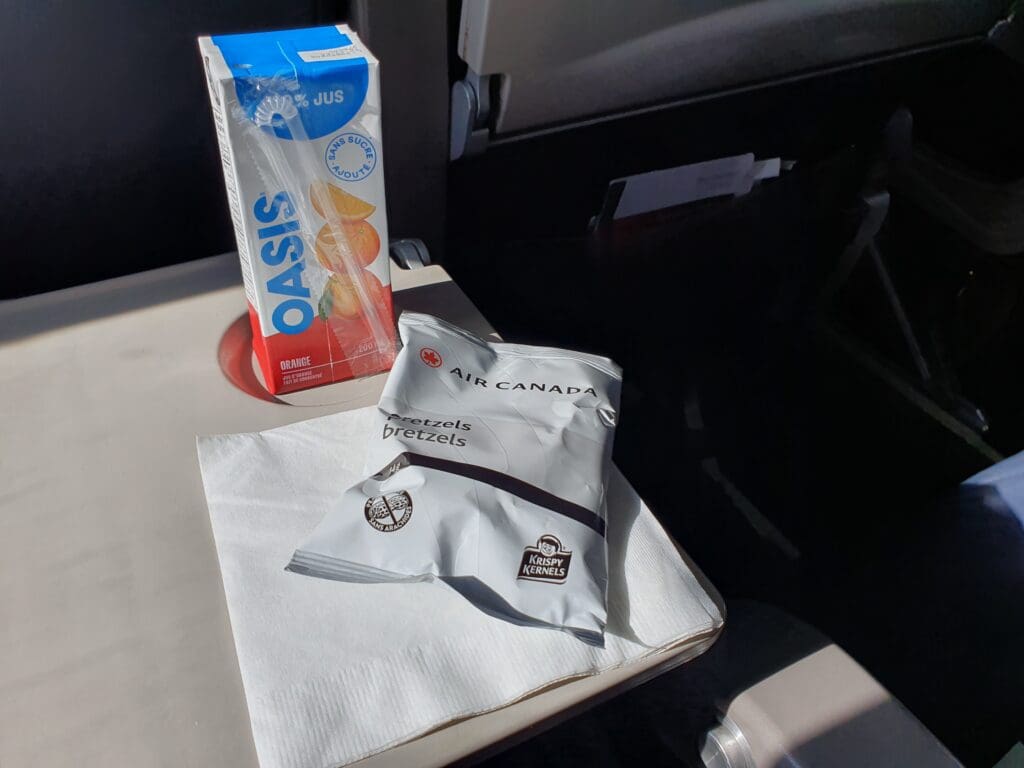
Almost as soon as I had received the inflight snack, the Dash 8 hit a particularly rough patch of turbulence and the seatbelt signs were reilluminated. This was then accompanied by an announcement from the Service Director with the usual pre-landing instructions, indeed only a total of two minutes after the aircraft had levelled off at its cruising altitude, this commenced its descent as it overflew the town of Drummondville. Despite only having just received my snack, the two crew members then passed through the cabin collecting rubbish and ensuring that all was in place for our arrival into Montréal.
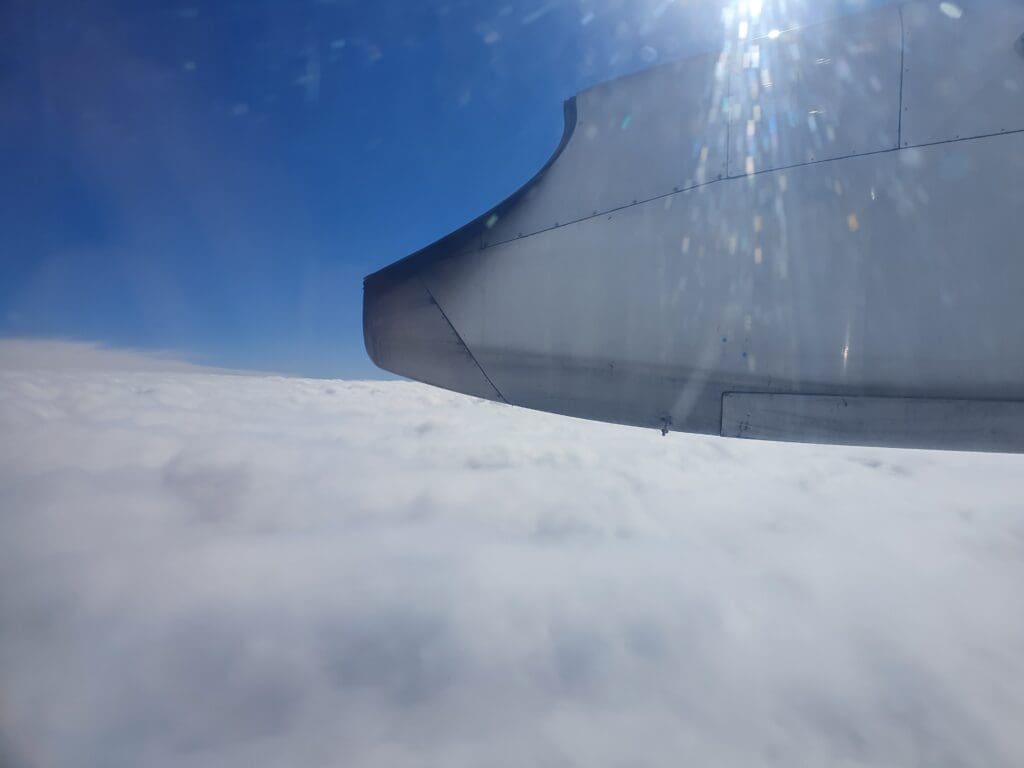
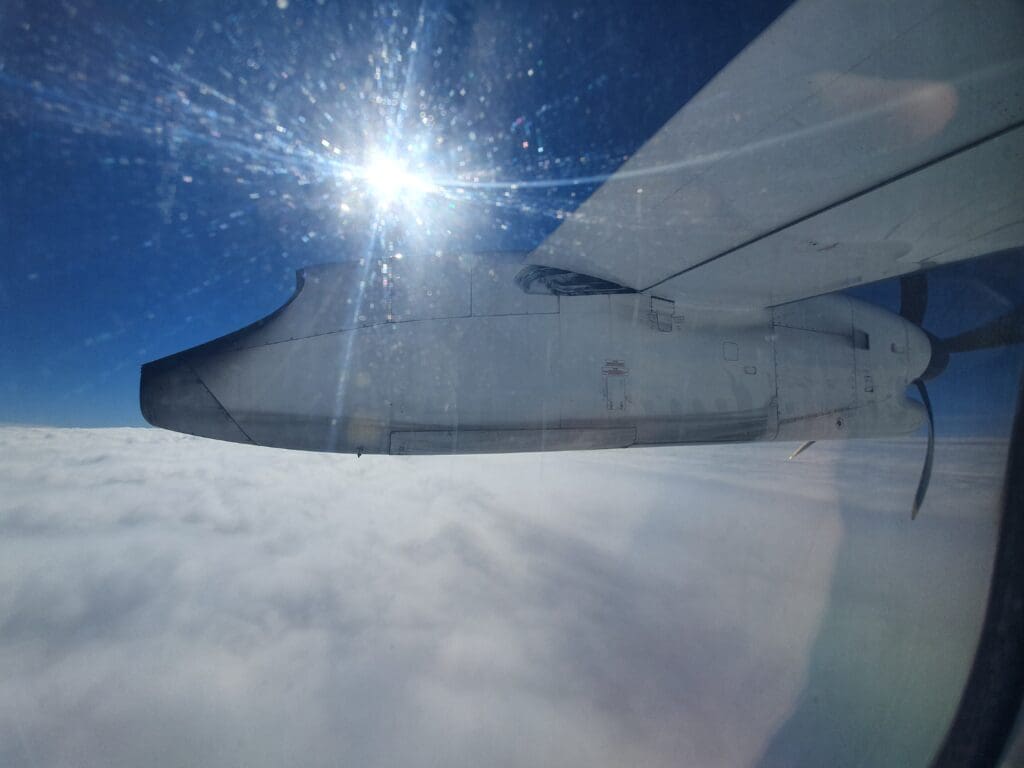
Once the aircraft passed through the clouds, the turbulence came to an end and the semi-rural landscape near the town of Saint-Hyacinthe came into view beneath the aircraft. After a minute or so of flying over a mixture of rectangular fields and forests, the aircraft reached the city of Boucherville on the south bank of the St Lawrence River before passing over Grosbois Island. At this point in the flight, sitting on the left-hand side of the aircraft, the tall buildings of central Montréal popped into view in the distance, meanwhile, a clear view of the city’s Olympic Stadium could be seen nearer the aircraft.


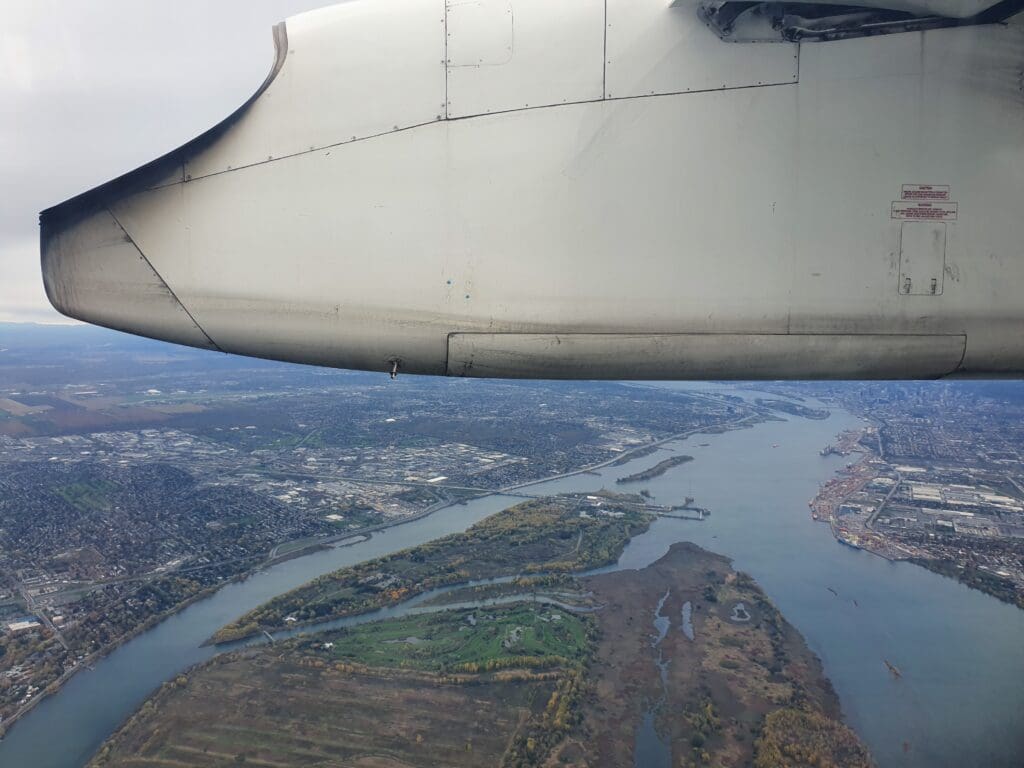
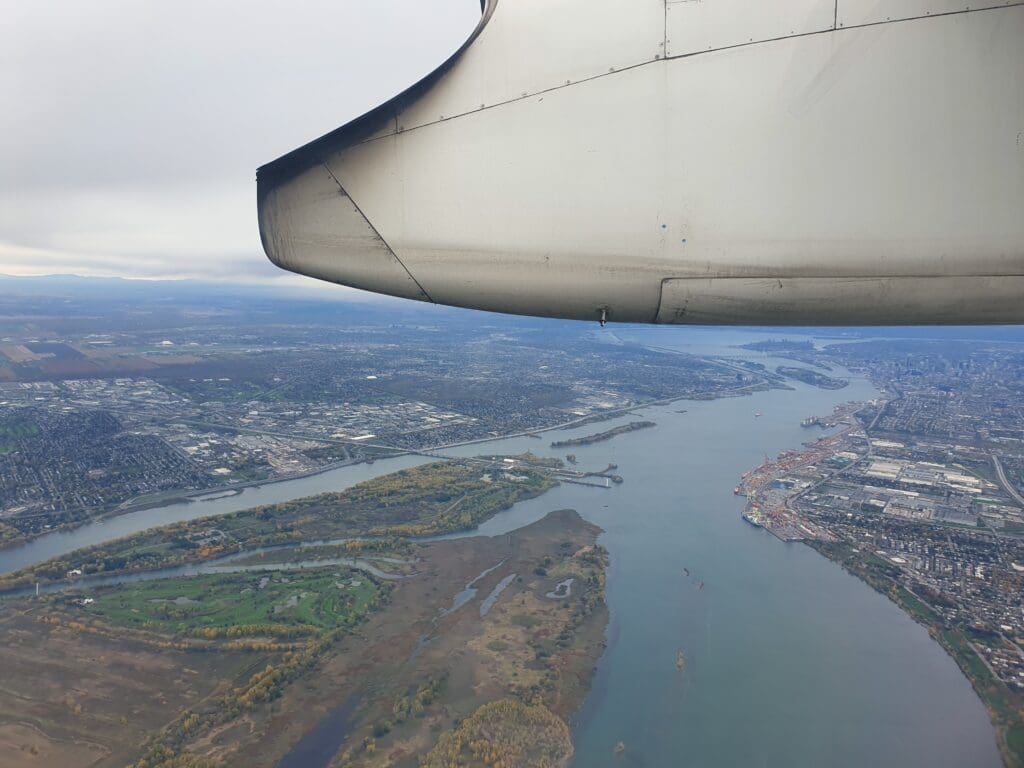
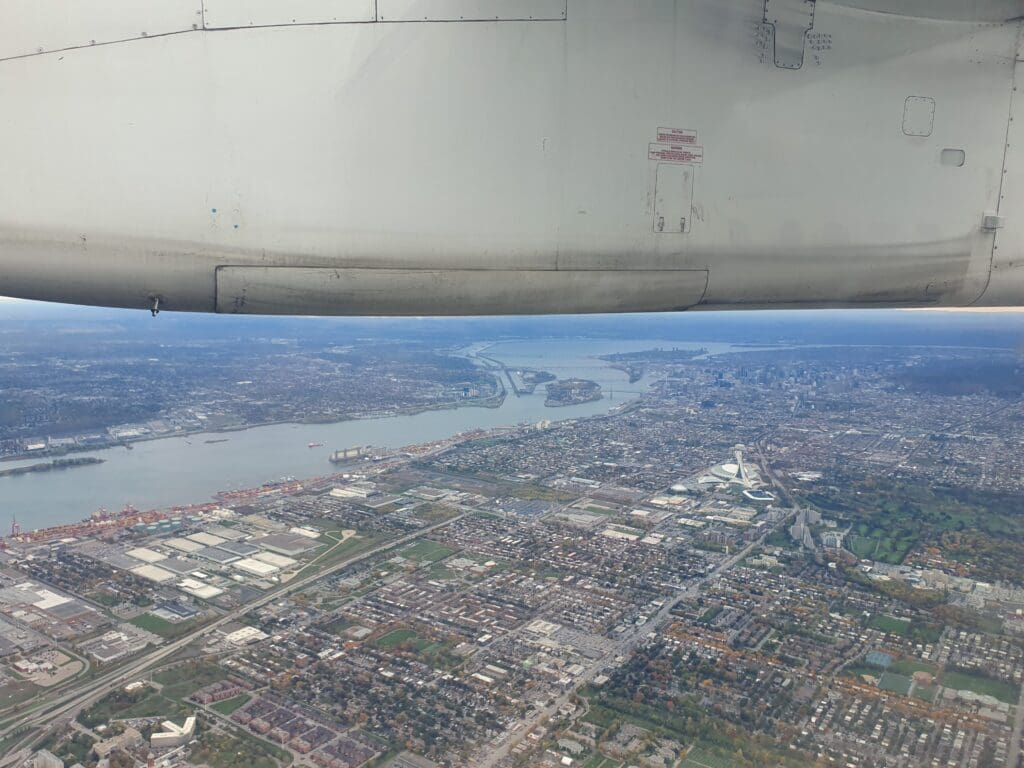
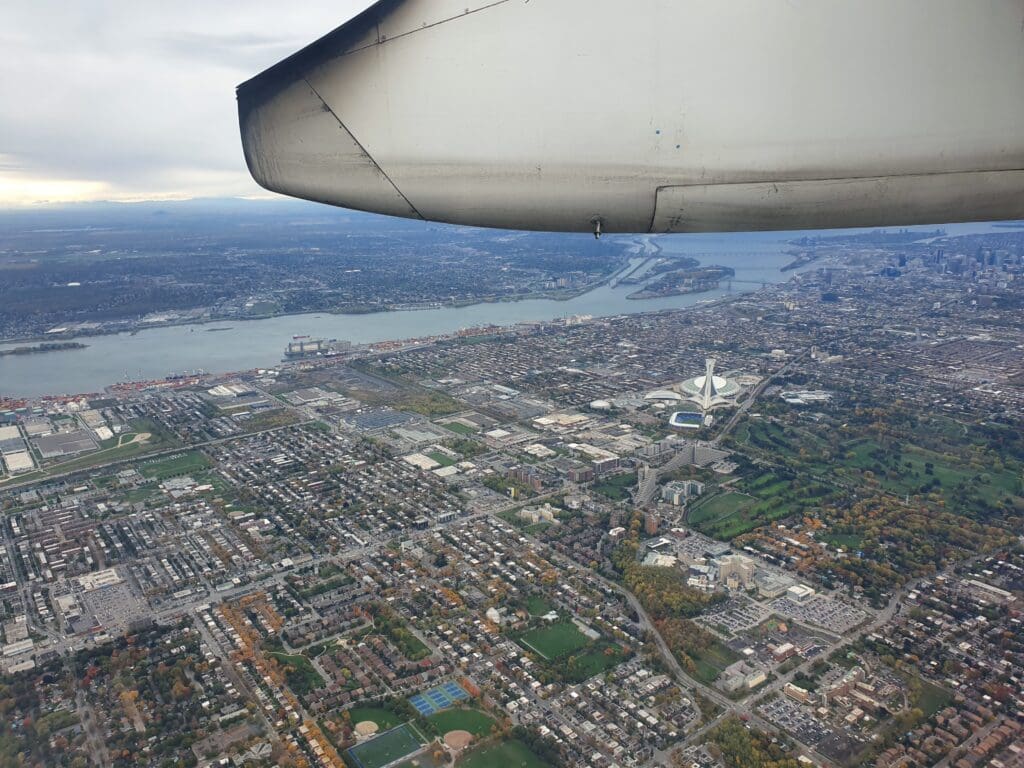
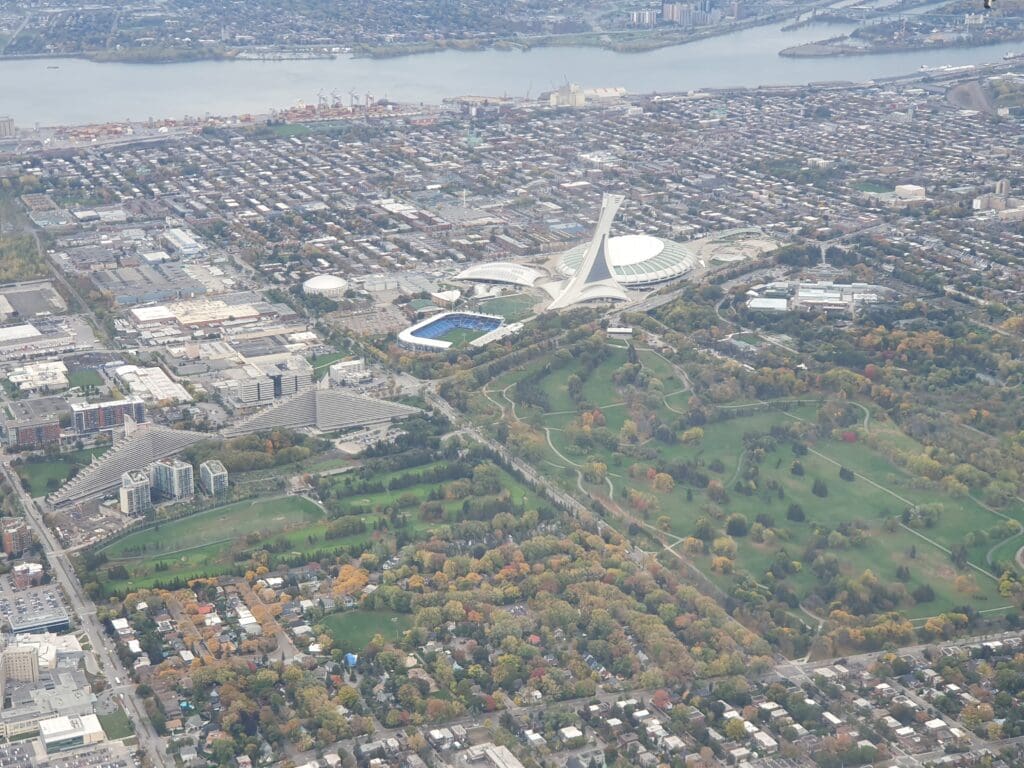
After crossing the St Lawrence River’s northern shores, the aircraft turned south to line itself up for an approach on Montréal-Trudeau Airport’s runway 24. Trundling across the city, beneath the aircraft, Montréal’s leafy, mostly flat and mostly residential neighbourhoods of Saint-Leonard, Little Italy and Villeray whizzed past. Meanwhile, in the distance, the city centre continued to be seen, as did Mount Royal at the heart of this. As the Dash 8 crossed over Jarry Park, the landing gear dropped into position and the flaps were extended in preparation for our arrival. After this, the University of Montréal could be seen, easily recognisable thanks to its art deco Roger Gaudry Pavillon and tall tower. This was soon followed by another of Montréal’s landmarks, Saint Joseph’s Oratory.
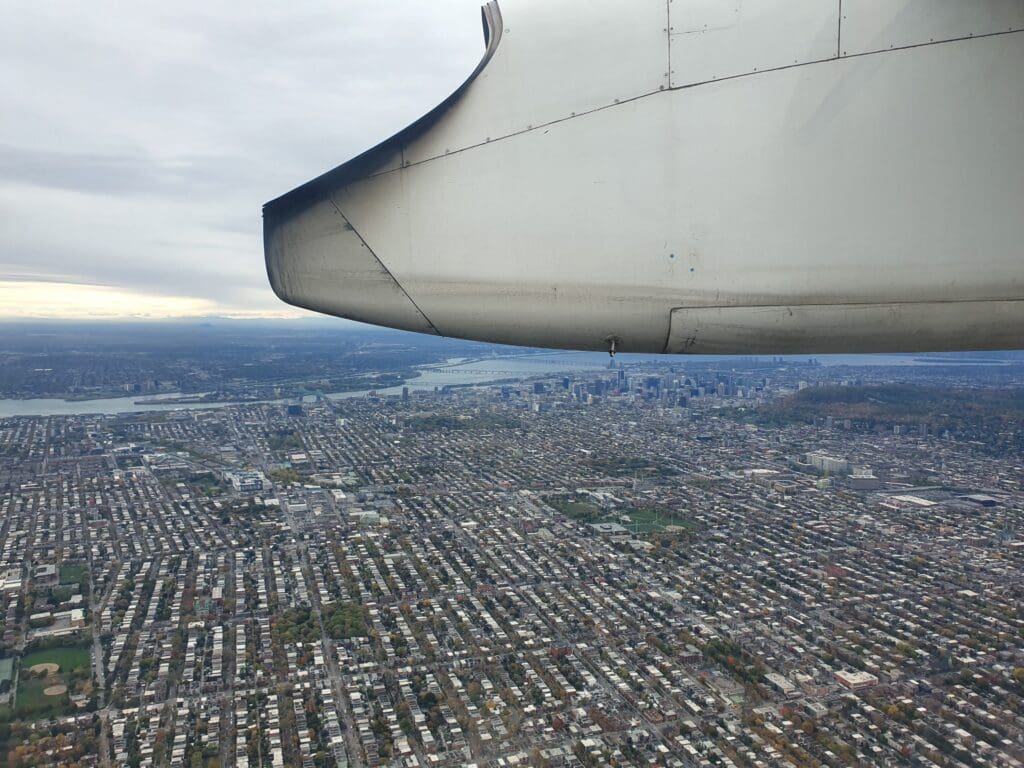
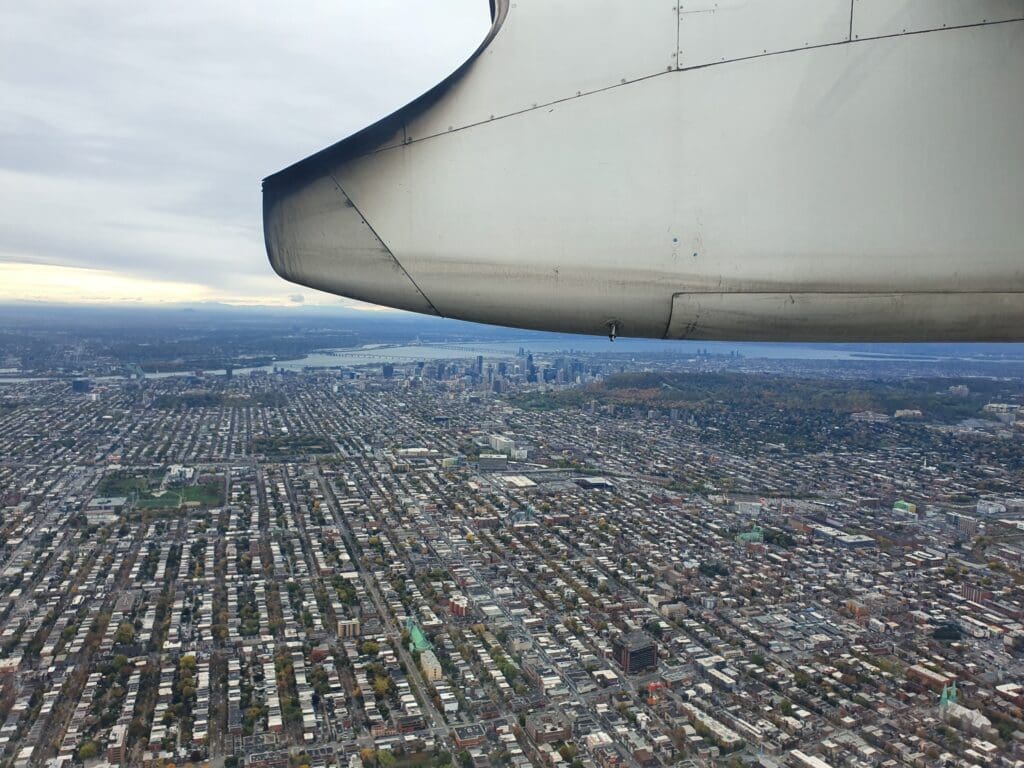
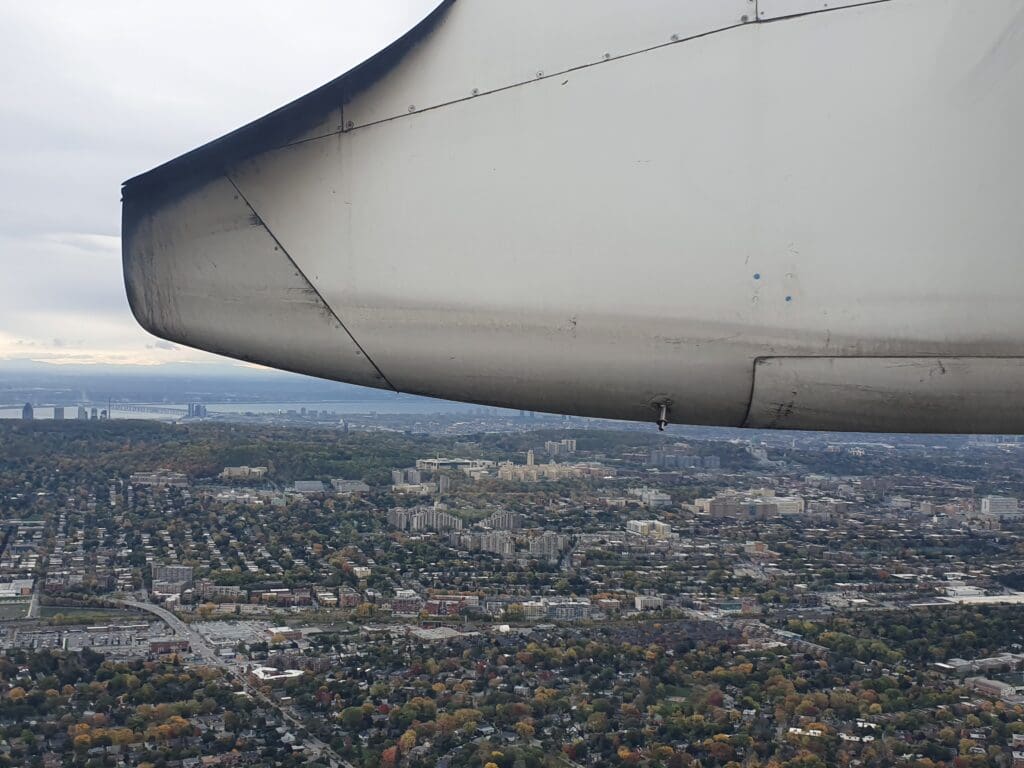
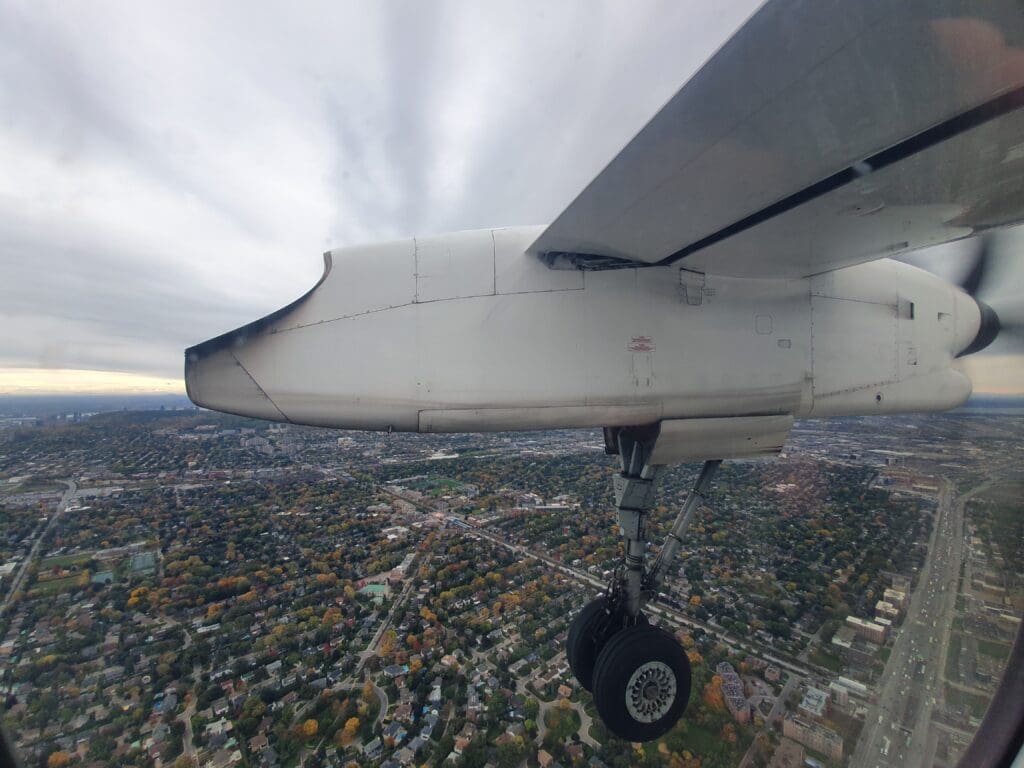
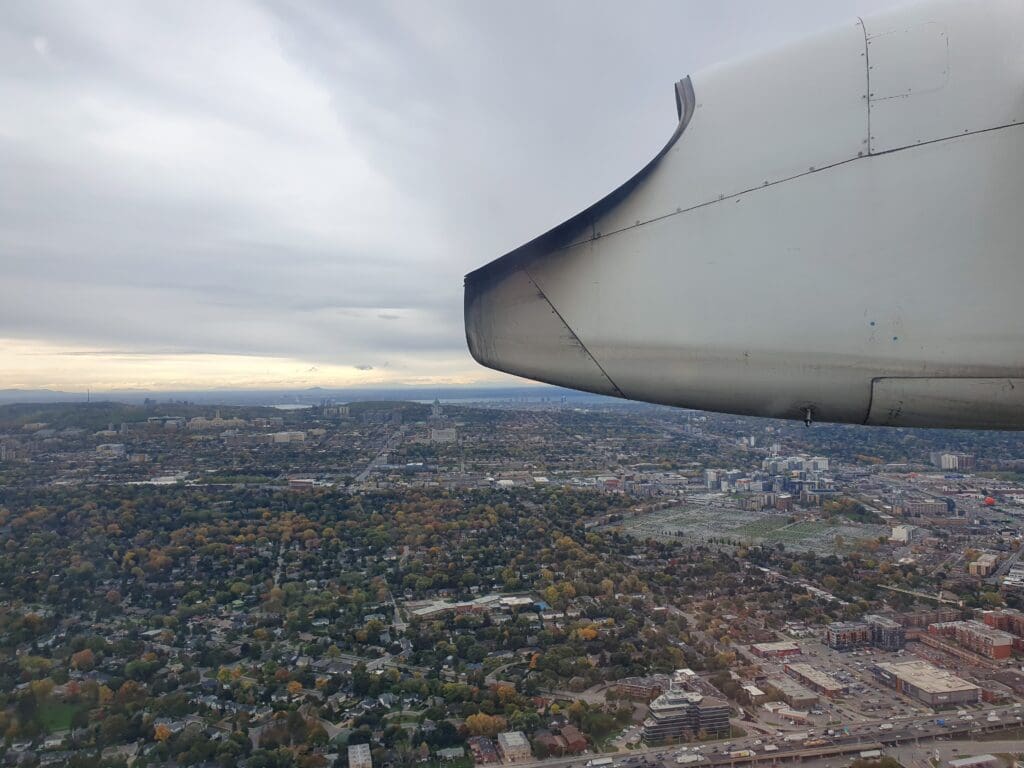
As the Dash 8 neared Montréal Airport, the city’s residential suburbs were replaced by the usual sprawl of industrial estates, hotels and car parks that surround airports the world over. At 1145, a grand total of 32 minutes after taking to the skies the aircraft made a firm touchdown on Runway 24L before gently braking as the collection of business jets and light aircraft parked to the east of the runway passed by. With Montréal Airport’s terminal located at the end of the runway and perhaps with no traffic directly behind our aircraft, the pilots appeared in no rush to exit the runway and eventually the Dash 8 vacated this near its end.

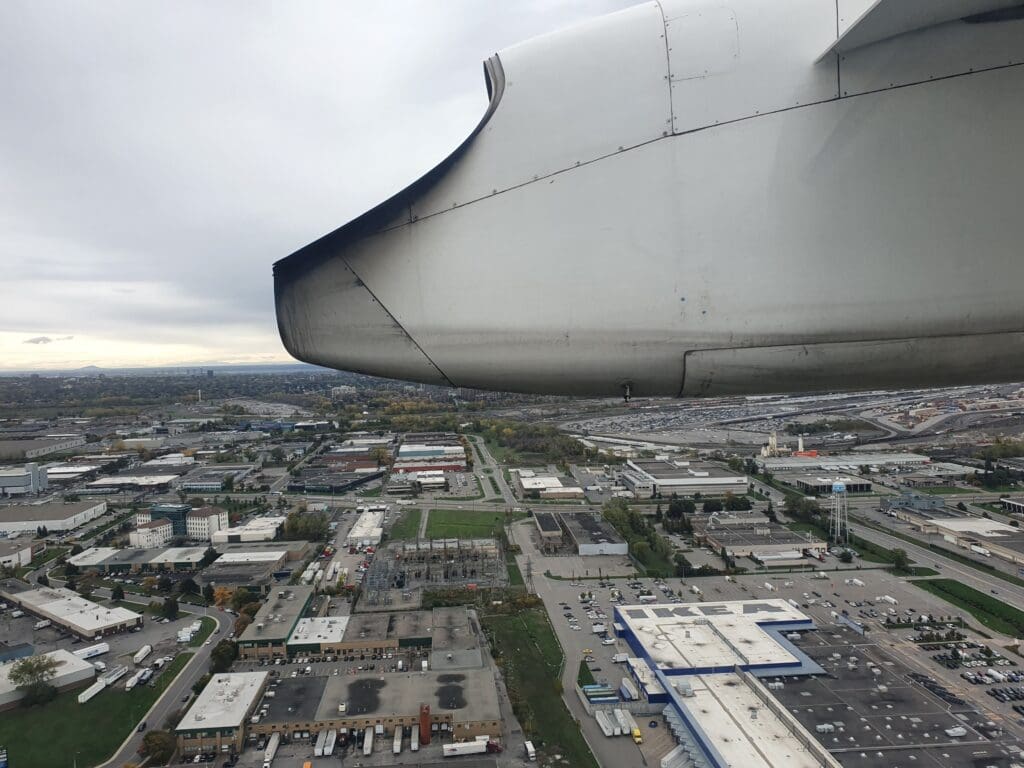

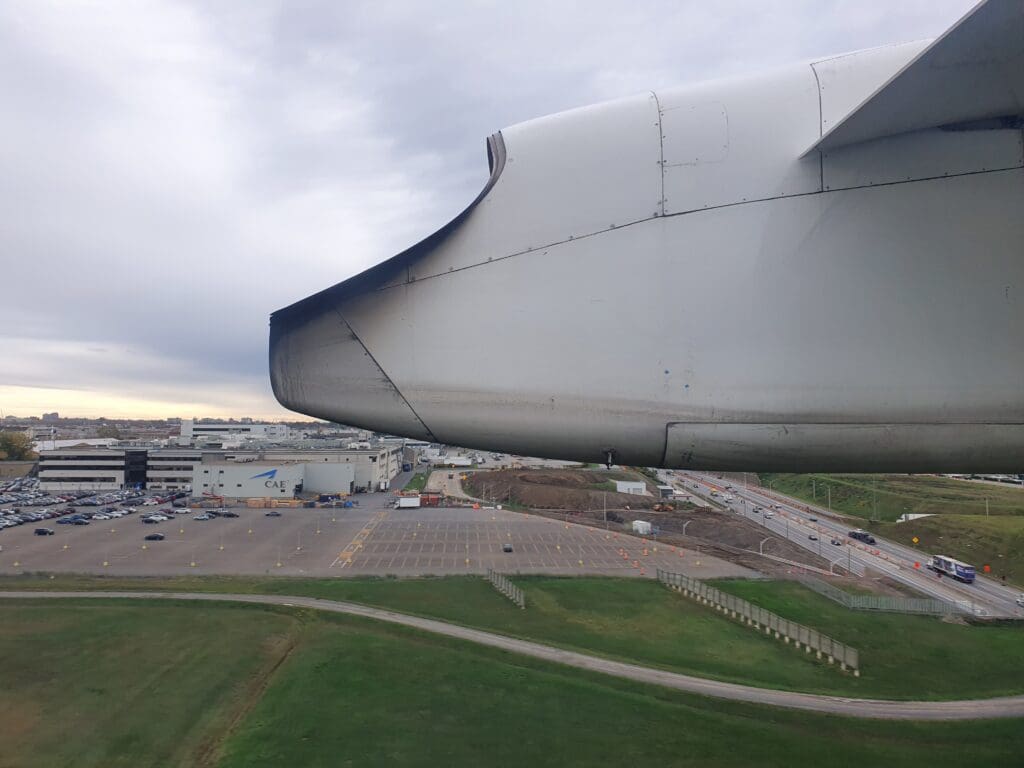
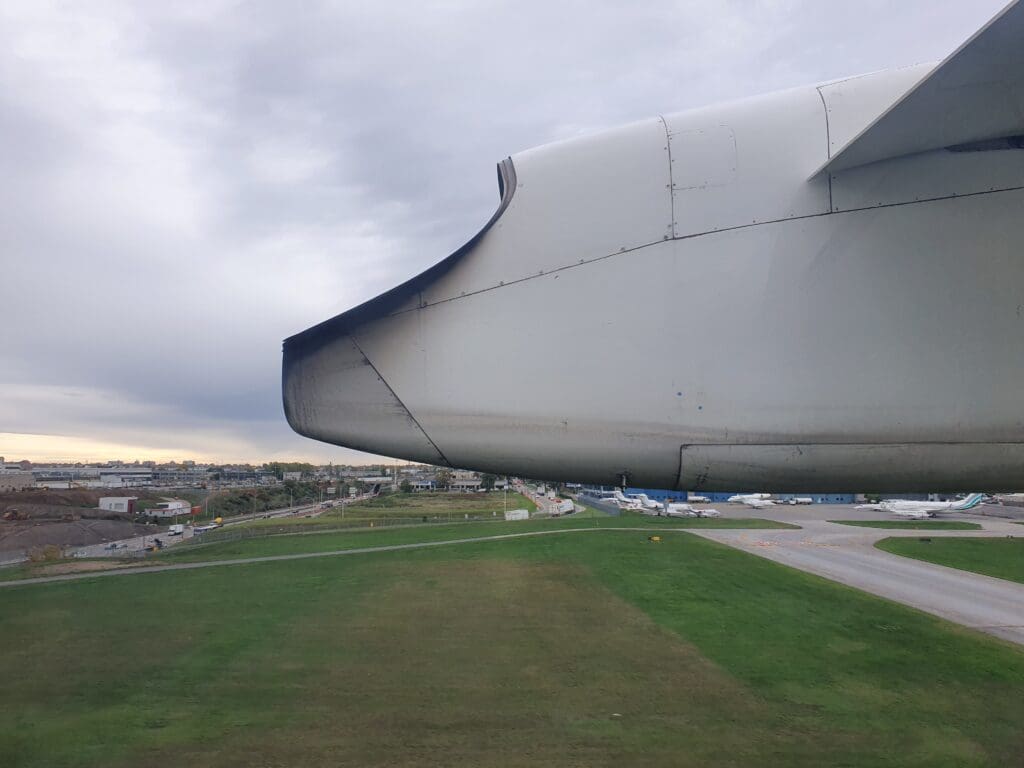
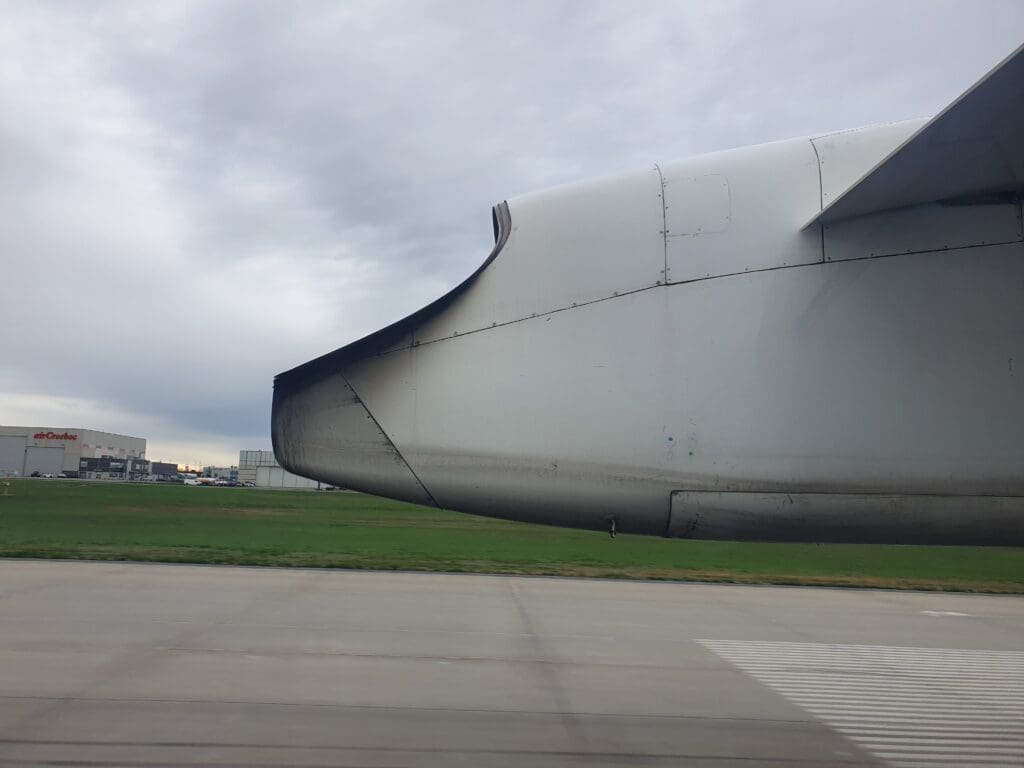
Once the aircraft had left the runway, the Service Director welcomed all to Montréal in French and English and gave the usual warning regarding keeping seatbelts fastened until the aircraft had reached the gate. A few moments later, the aircraft came to a halt and as is common with Dash 8s during their post-landing taxi, the port engine powered down and its propeller soon stopped whirling. After a minute or so of no movement, the Captain made an announcement informing passengers that due to our early arrival, staff members were yet to arrive at the arrival gate and so the aircraft would have to hold for up to five minutes until staff appeared at the gate.
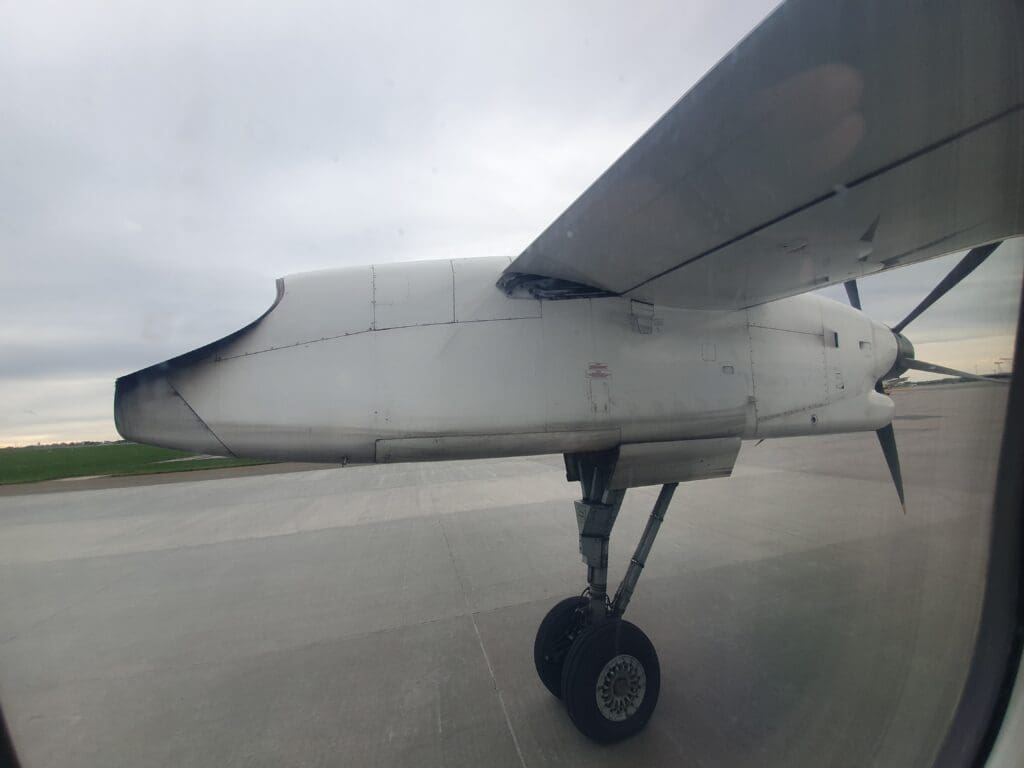
Around two minutes after this announcement had been made, the aircraft recommenced its taxi and pulled into Gate 15, coming to a gentle halt at which time the remaining engine spooled down. As soon as the seatbelt signs were switched off, many, seemingly in a rush to catch their connecting flights, stood up and retrieved their bags from the overhead lockers. Looking forward, whilst the cabin door was opened quickly, it took around four minutes for the jet bridge and gangway to be positioned and for disembarkation to commence. Joining the queue of disembarking passengers, it took some time to reach the front of the aircraft and eventually, I thanked the Service Director, receiving nothing in response before exiting the aircraft and heading up the jetway to commence my Montréal connection experience.

